Shows
 Science In Your Shopping CartSeason 4: Berries | Episode 1: BlueberriesLearn how a USDA breeding program was responsible for the development of the blueberry growing industry in the southeastern United States and how ARS scientists have developed and are continuing to work with farmers to create new cultivars of blueberries that we all get to enjoy.Connect with us: Twitter: @USDA_ARSFacebook: @AgriculturalResearchServiceLinkedIn: @usda-ars2025-07-2907 min
Science In Your Shopping CartSeason 4: Berries | Episode 1: BlueberriesLearn how a USDA breeding program was responsible for the development of the blueberry growing industry in the southeastern United States and how ARS scientists have developed and are continuing to work with farmers to create new cultivars of blueberries that we all get to enjoy.Connect with us: Twitter: @USDA_ARSFacebook: @AgriculturalResearchServiceLinkedIn: @usda-ars2025-07-2907 min Science In Your Shopping CartSeason 1: Tomatoes, Potatoes & Spinach | Episode 1: TomatoesWhere was the Roma tomato developed? Rome? Nope, the answer may surprise you. Learn this and more interesting facts about the Roma tomato.Connect with us: Twitter: @USDA_ARSFacebook: @AgriculturalResearchServiceLinkedIn: @usda-ars2025-07-2205 min
Science In Your Shopping CartSeason 1: Tomatoes, Potatoes & Spinach | Episode 1: TomatoesWhere was the Roma tomato developed? Rome? Nope, the answer may surprise you. Learn this and more interesting facts about the Roma tomato.Connect with us: Twitter: @USDA_ARSFacebook: @AgriculturalResearchServiceLinkedIn: @usda-ars2025-07-2205 min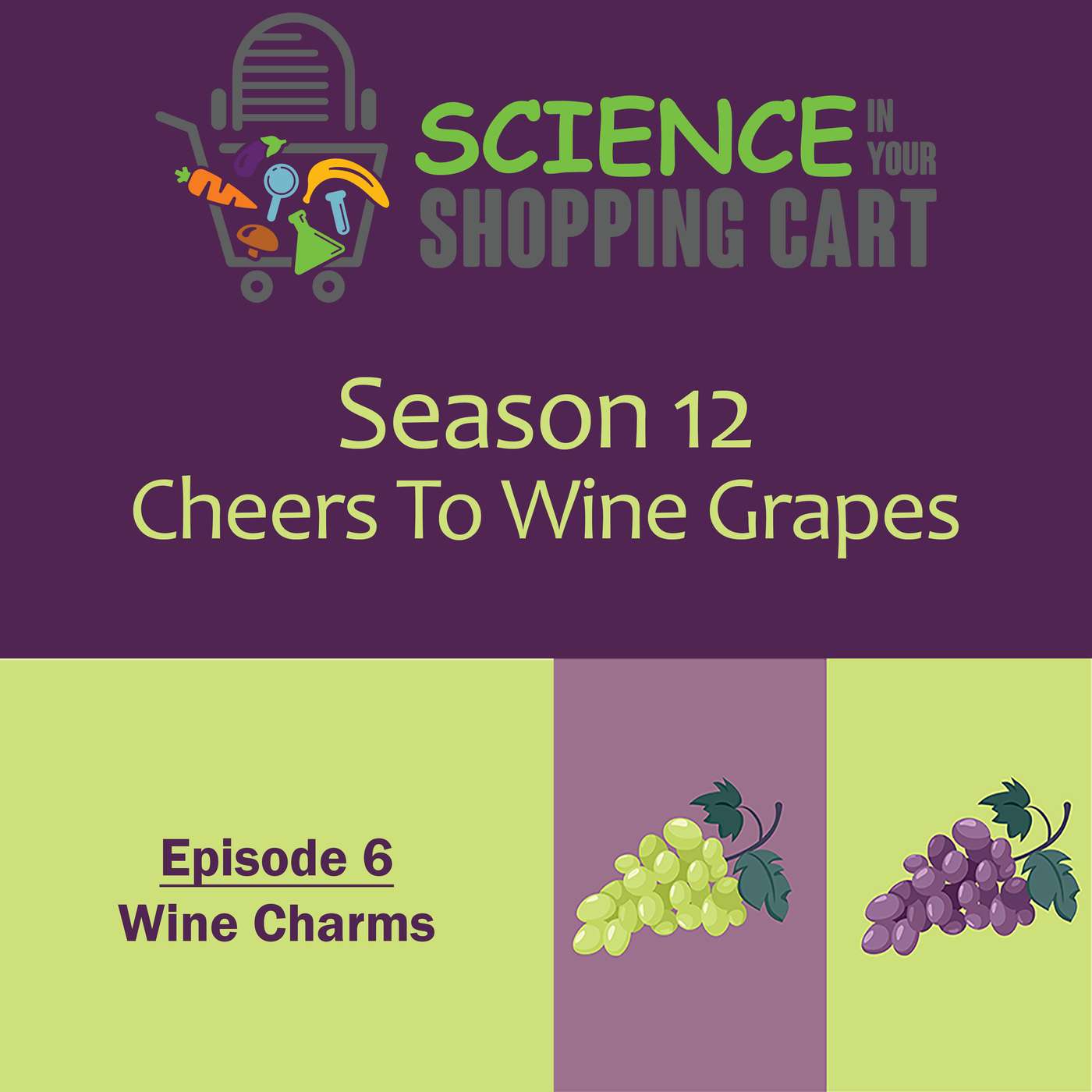 Science In Your Shopping CartSeason 12: Cheers To Wine Grapes | Episode 6: Wine CharmsThe USDA’s Agricultural Research Service (ARS) protects and helps the wine industry thrive in the United States. Learn some fun facts to share at your next wine tasting including the birthplace of American wine.Connect with us: Twitter: @USDA_ARSFacebook: @AgriculturalResearchServiceLinkedIn: @usda-ars2025-06-1005 min
Science In Your Shopping CartSeason 12: Cheers To Wine Grapes | Episode 6: Wine CharmsThe USDA’s Agricultural Research Service (ARS) protects and helps the wine industry thrive in the United States. Learn some fun facts to share at your next wine tasting including the birthplace of American wine.Connect with us: Twitter: @USDA_ARSFacebook: @AgriculturalResearchServiceLinkedIn: @usda-ars2025-06-1005 min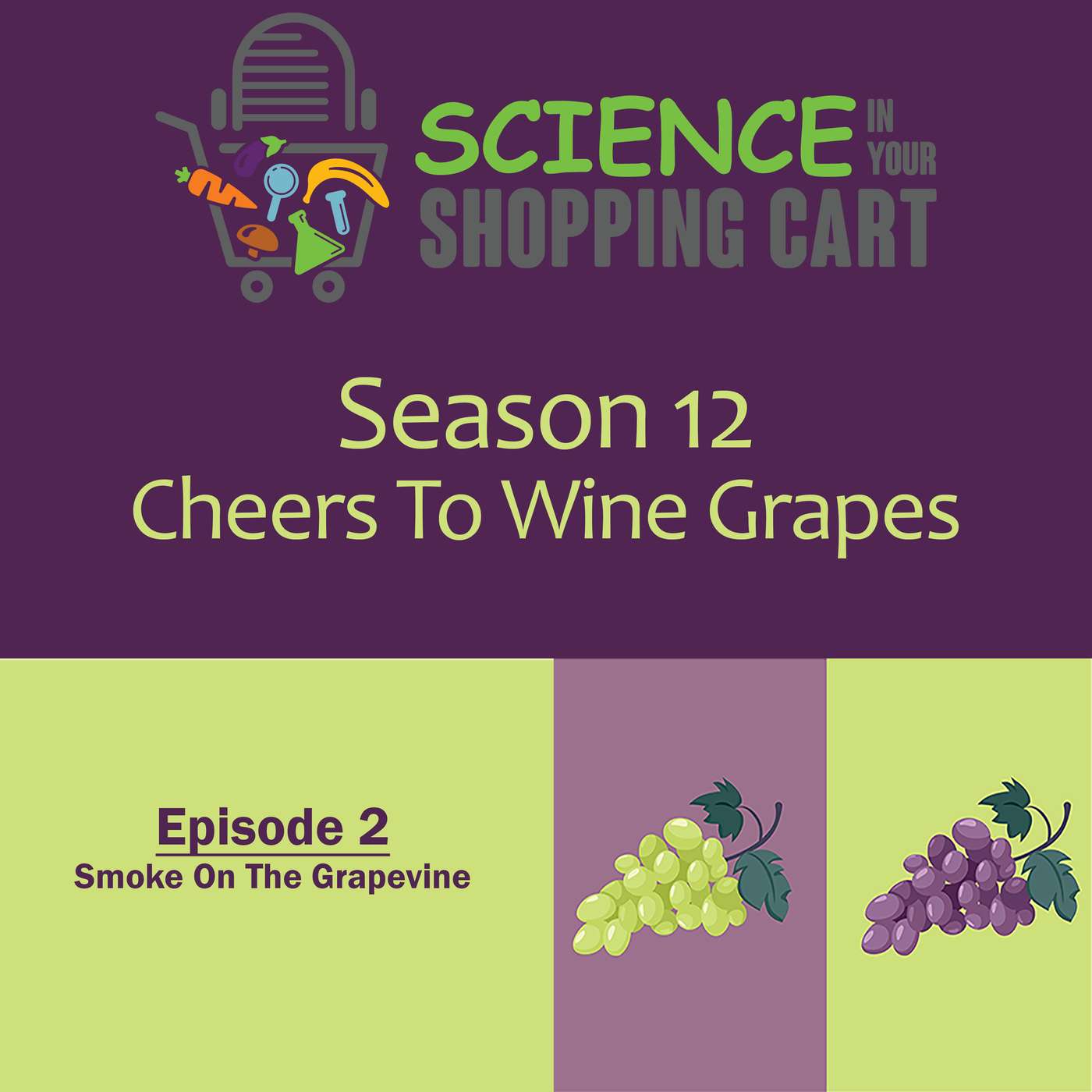 Science In Your Shopping CartSeason 12: Cheers To Wine Grapes | Episode 2: Smoke On The GrapevineARS researcher Arran Rumbaugh, a research chemist at the Crops Pathology and Genetics Research Unit in Davis, CA, is studying how smoke from wildfires can affect the chemical composition of wine grapes. Wildfires from 2020 hurt wine grape production and had an estimated 3.7 billion dollars of economic impact on the wine industry due to smoke exposure and fire. Dr. Rumbaugh is working on an early screening method that could quickly detect the smoke exposure and impact on grapevines. This ARS research has the potential to save time, money, and millions of wine grapes. To...2025-05-1308 min
Science In Your Shopping CartSeason 12: Cheers To Wine Grapes | Episode 2: Smoke On The GrapevineARS researcher Arran Rumbaugh, a research chemist at the Crops Pathology and Genetics Research Unit in Davis, CA, is studying how smoke from wildfires can affect the chemical composition of wine grapes. Wildfires from 2020 hurt wine grape production and had an estimated 3.7 billion dollars of economic impact on the wine industry due to smoke exposure and fire. Dr. Rumbaugh is working on an early screening method that could quickly detect the smoke exposure and impact on grapevines. This ARS research has the potential to save time, money, and millions of wine grapes. To...2025-05-1308 min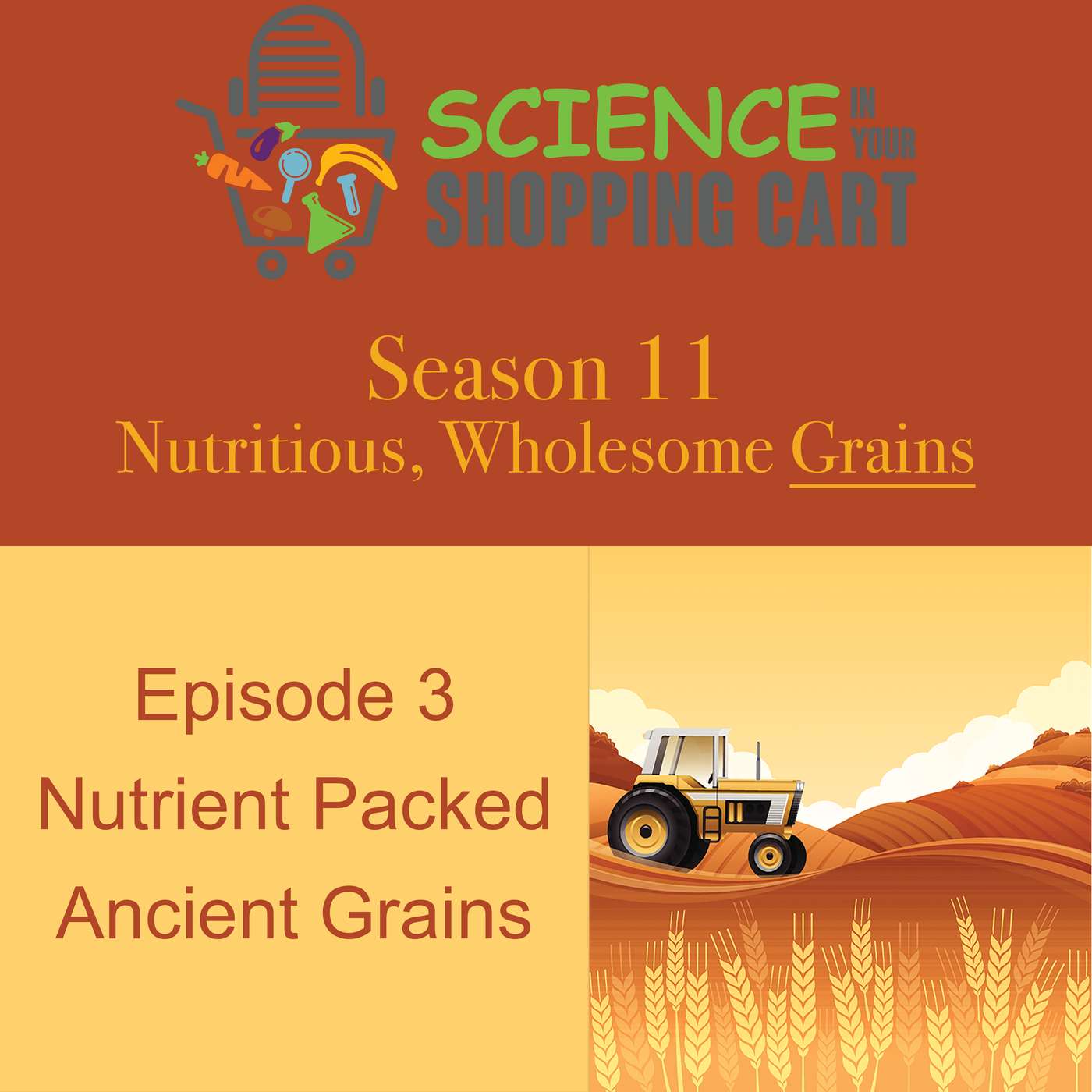 Science In Your Shopping CartSeason 11: Wholesome, Nutritious Grains | Episode 3: Nutrient Packed Ancient GrainsAncient grains refers to a category of grains – particularly pseudo-cereals – that possess a very unique health benefit that provide essential nutritional requirements for our health. ARS Research Leader, Dr. Sean Liu at the Functional Foods Research Unit in Peoria, Illinois is researching ways to make ancient grains more nutritional, and he wants to make them more attractive to consumers. Click on the link below to view our Cooking With Science videos on Buckwheat and several other tasty recipes. https://aglab.ars.usda.gov/sights-and-sounds/cooking-with-scienceConnect with us: Twitter: @USDA_ARSFaceb...2025-03-1809 min
Science In Your Shopping CartSeason 11: Wholesome, Nutritious Grains | Episode 3: Nutrient Packed Ancient GrainsAncient grains refers to a category of grains – particularly pseudo-cereals – that possess a very unique health benefit that provide essential nutritional requirements for our health. ARS Research Leader, Dr. Sean Liu at the Functional Foods Research Unit in Peoria, Illinois is researching ways to make ancient grains more nutritional, and he wants to make them more attractive to consumers. Click on the link below to view our Cooking With Science videos on Buckwheat and several other tasty recipes. https://aglab.ars.usda.gov/sights-and-sounds/cooking-with-scienceConnect with us: Twitter: @USDA_ARSFaceb...2025-03-1809 min Come Rain or ShineCelebrating Milestones: 10 Years of Supporting ResilienceThis month we are celebrating major milestones and want to share those with you. The Climate Hub network just celebrated its 10 year anniversary. As part of that anniversary our partners recorded short stories about some of their favorite projects. We have compiled a selection of those for this episode to kick off the new year.Relevant links:USDA Climate Hubs: Stories from Our First 10 YearsUSDA Climate Hubs: Celebrating 10 Years!If you’re enjoying this podcast, please consider rating us and/or le...2025-01-0122 min
Come Rain or ShineCelebrating Milestones: 10 Years of Supporting ResilienceThis month we are celebrating major milestones and want to share those with you. The Climate Hub network just celebrated its 10 year anniversary. As part of that anniversary our partners recorded short stories about some of their favorite projects. We have compiled a selection of those for this episode to kick off the new year.Relevant links:USDA Climate Hubs: Stories from Our First 10 YearsUSDA Climate Hubs: Celebrating 10 Years!If you’re enjoying this podcast, please consider rating us and/or le...2025-01-0122 min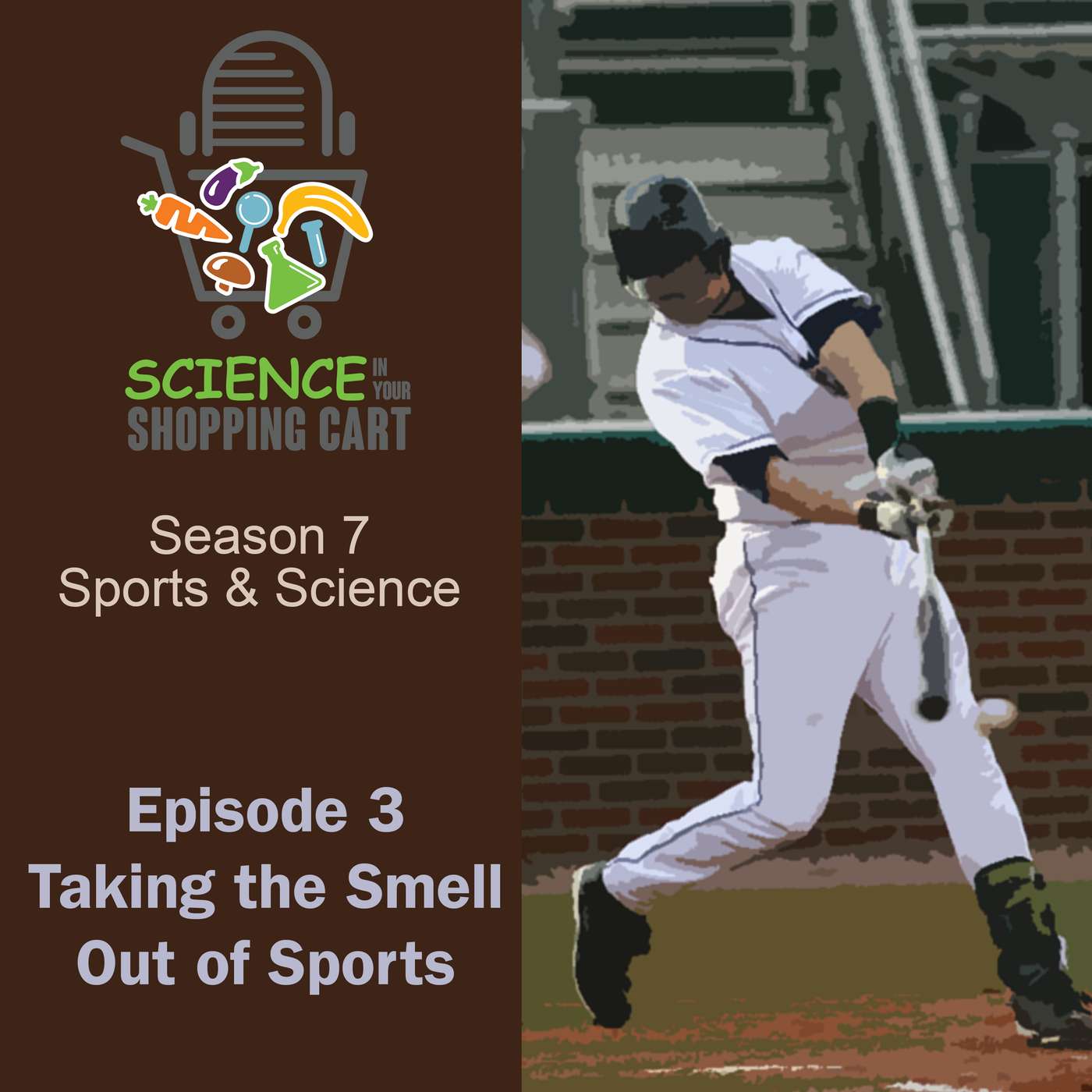 Science In Your Shopping CartSeason 7: Sports and Science | Episode 3: Taking the Smell Out of SportsNanoparticles help protect your body from germs and other microbials, it also fights body odor, especially from sweating. ARS researchers have figured out a better way for for attaching nanoparticles to clothing.Connect with us: Twitter: @USDA_ARSFacebook: @AgriculturalResearchServiceLinkedIn: @usda-ars2024-07-3007 min
Science In Your Shopping CartSeason 7: Sports and Science | Episode 3: Taking the Smell Out of SportsNanoparticles help protect your body from germs and other microbials, it also fights body odor, especially from sweating. ARS researchers have figured out a better way for for attaching nanoparticles to clothing.Connect with us: Twitter: @USDA_ARSFacebook: @AgriculturalResearchServiceLinkedIn: @usda-ars2024-07-3007 min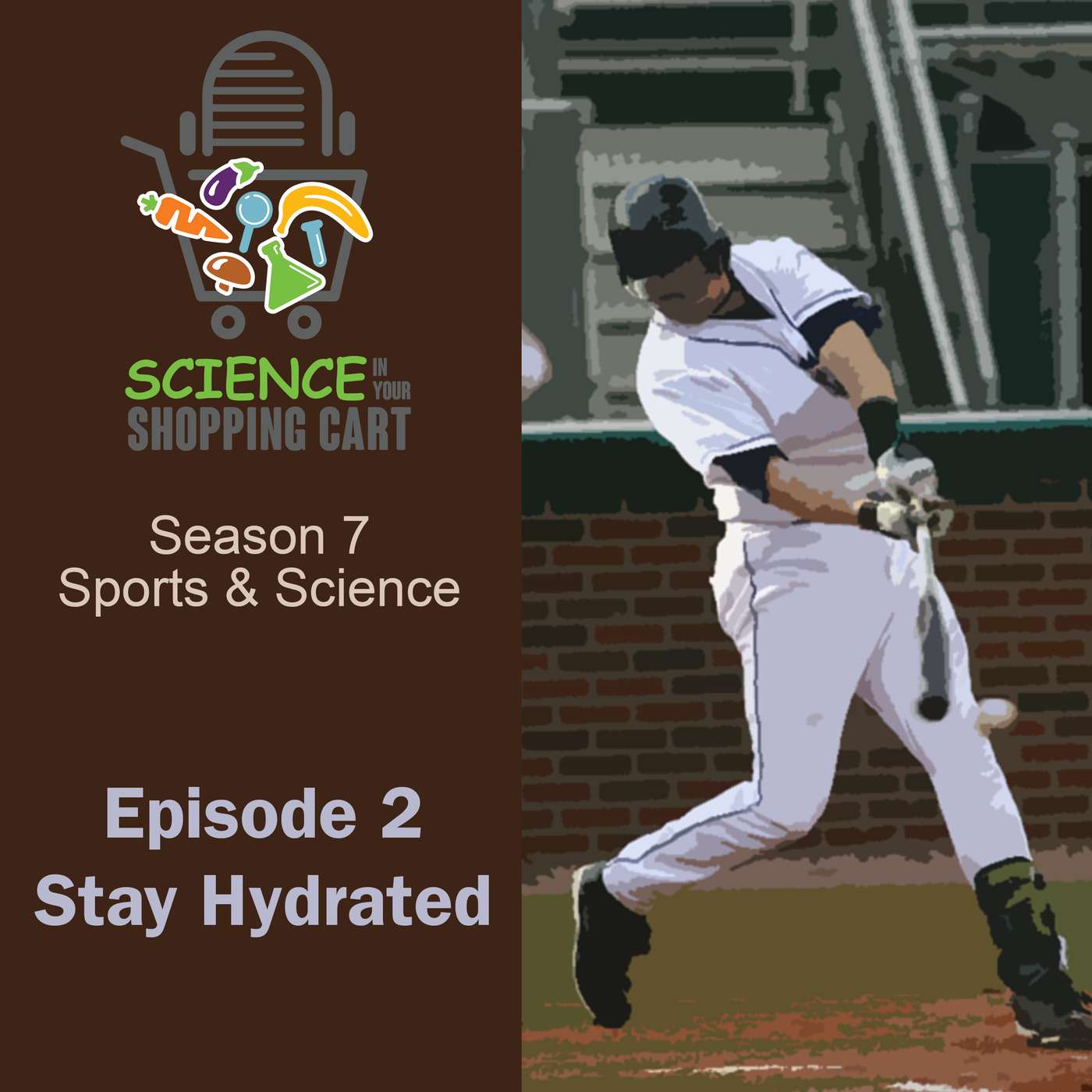 Science In Your Shopping CartSeason 7: Sports and Science | Episode 2: Stay HydratedHydration is so important to our bodies during exercise, perhaps more important than the exercise itself. Not properly hydrating during athletic competitions or every day exercising – even walking – can have damaging effects on our bodies. Of course, there are the physical effects, such as fatigue, exhaustion, and heat stroke. But there are also psychological factors that you may not be aware of. Learn more about how hydration affects your body in this podcast.Connect with us: Twitter: @USDA_ARSFacebook: @AgriculturalResearchServiceLinkedIn: @usda-ars2024-07-2309 min
Science In Your Shopping CartSeason 7: Sports and Science | Episode 2: Stay HydratedHydration is so important to our bodies during exercise, perhaps more important than the exercise itself. Not properly hydrating during athletic competitions or every day exercising – even walking – can have damaging effects on our bodies. Of course, there are the physical effects, such as fatigue, exhaustion, and heat stroke. But there are also psychological factors that you may not be aware of. Learn more about how hydration affects your body in this podcast.Connect with us: Twitter: @USDA_ARSFacebook: @AgriculturalResearchServiceLinkedIn: @usda-ars2024-07-2309 min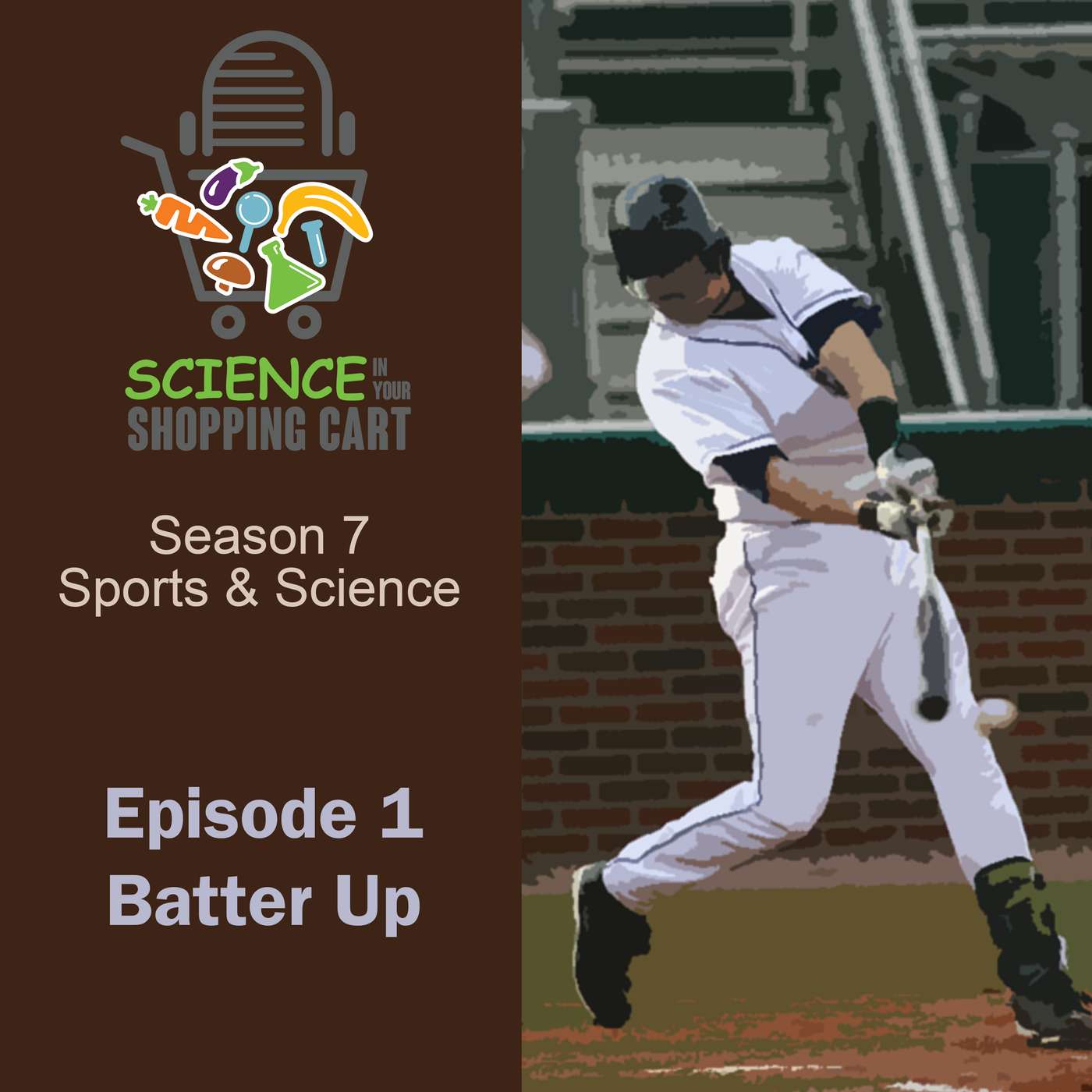 Science In Your Shopping CartSeason 7: Sports and Science | Episode 1: Batter UpThe sport of baseball is woven into America’s culture like the uniforms worn by the players. Baseball has been around for nearly 150 years, and in that time we’ve seen plenty of home run sluggers, from Babe Ruth and Hank Aaron to Alex Rodriguez and Ken Griffey, Jr., to todays mashers like Aaron Judge and Mike Trout. Did you know that most professional baseball bats are made from either maple or ash? ARS researchers help keep America’s pastime swinging for the fences by protecting Ash trees from the Emerald Ash Borer.Connect with us:2024-07-1613 min
Science In Your Shopping CartSeason 7: Sports and Science | Episode 1: Batter UpThe sport of baseball is woven into America’s culture like the uniforms worn by the players. Baseball has been around for nearly 150 years, and in that time we’ve seen plenty of home run sluggers, from Babe Ruth and Hank Aaron to Alex Rodriguez and Ken Griffey, Jr., to todays mashers like Aaron Judge and Mike Trout. Did you know that most professional baseball bats are made from either maple or ash? ARS researchers help keep America’s pastime swinging for the fences by protecting Ash trees from the Emerald Ash Borer.Connect with us:2024-07-1613 min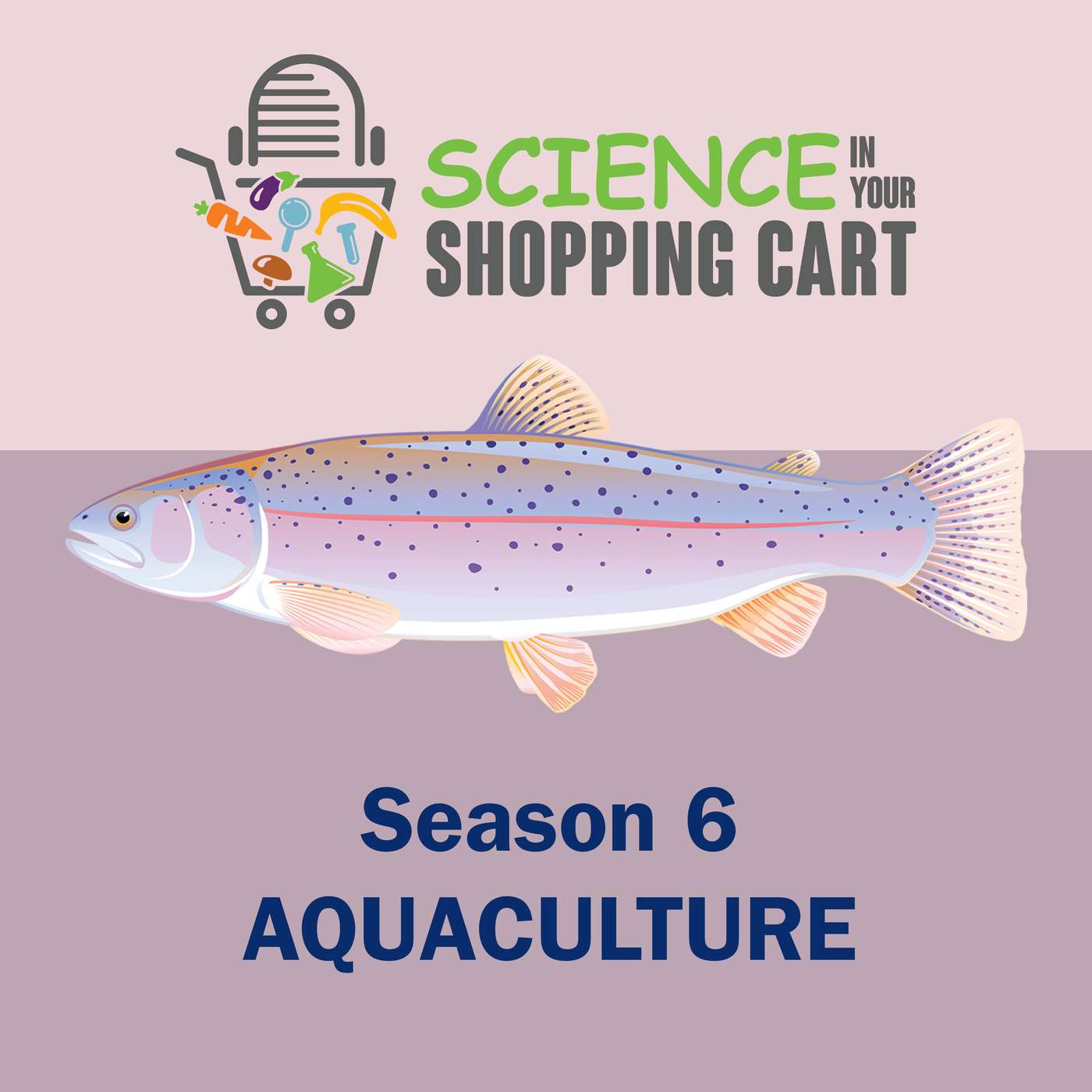 Science In Your Shopping CartSeason 6: AquacultureOn this season of Science in Your Shopping Cart, we take a deep dive in to seafood production in the U.S. Learn how research facilities across the country are developing new fish farming techniques, new strains of fish, are keeping fish healthy, and creating more sustainable methods for raising finfish and shellfish.Connect with us: Twitter: @USDA_ARSFacebook: @AgriculturalResearchServiceLinkedIn: @usda-ars2024-07-1050 min
Science In Your Shopping CartSeason 6: AquacultureOn this season of Science in Your Shopping Cart, we take a deep dive in to seafood production in the U.S. Learn how research facilities across the country are developing new fish farming techniques, new strains of fish, are keeping fish healthy, and creating more sustainable methods for raising finfish and shellfish.Connect with us: Twitter: @USDA_ARSFacebook: @AgriculturalResearchServiceLinkedIn: @usda-ars2024-07-1050 min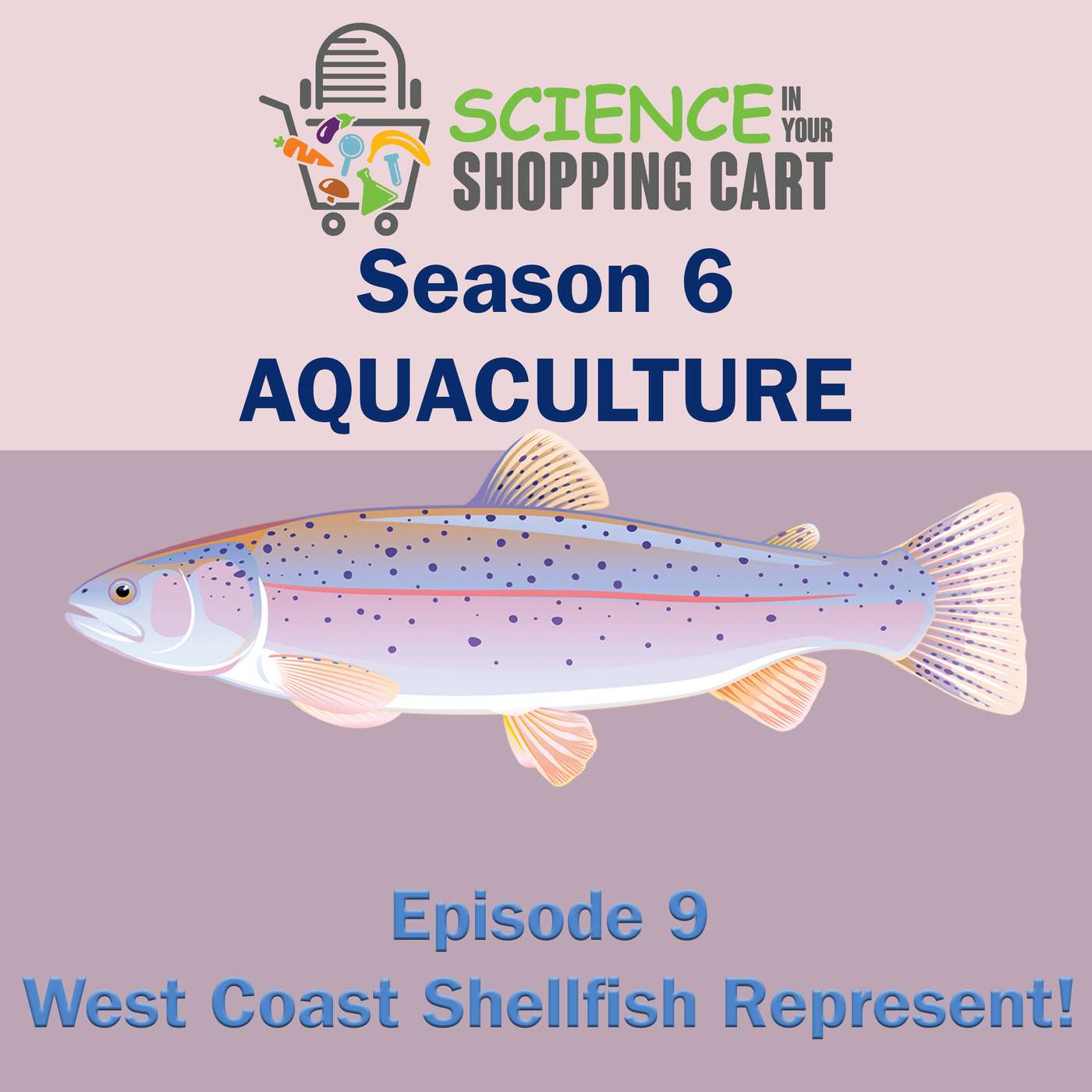 Science In Your Shopping CartSeason 6: Aquaculture | Episode 9: West Coast Shellfish Represent!Learn how ARS scientists are working with Oregon State University to produce new strains of the Pacific Oyster and protect them from a serious disease that’s recently been invading our waters.Connect with us: Twitter: @USDA_ARSFacebook: @AgriculturalResearchServiceLinkedIn: @usda-ars2024-07-0906 min
Science In Your Shopping CartSeason 6: Aquaculture | Episode 9: West Coast Shellfish Represent!Learn how ARS scientists are working with Oregon State University to produce new strains of the Pacific Oyster and protect them from a serious disease that’s recently been invading our waters.Connect with us: Twitter: @USDA_ARSFacebook: @AgriculturalResearchServiceLinkedIn: @usda-ars2024-07-0906 min Come Rain or ShineBurping Cows! Measuring Methane Emissions from CattleAccording to 2022 statistics published by the US EPA, enteric fermentation (a digestive pathway that produces gasses in the gut) by cattle accounted for around 3% of total US greenhouse gas emissions when converted to carbon dioxide equivalents. We spoke with Dr. Glenn Duff, from New Mexico State University to learn more about the research he and his team are conducting to measure gas fluxes and emissions from cattle in pursuit of improving efficiency and lowering emissions from this sector.Relevant Links:Greenhouse Gas Inventory Data Explorer from the US EPA2024-07-0323 min
Come Rain or ShineBurping Cows! Measuring Methane Emissions from CattleAccording to 2022 statistics published by the US EPA, enteric fermentation (a digestive pathway that produces gasses in the gut) by cattle accounted for around 3% of total US greenhouse gas emissions when converted to carbon dioxide equivalents. We spoke with Dr. Glenn Duff, from New Mexico State University to learn more about the research he and his team are conducting to measure gas fluxes and emissions from cattle in pursuit of improving efficiency and lowering emissions from this sector.Relevant Links:Greenhouse Gas Inventory Data Explorer from the US EPA2024-07-0323 min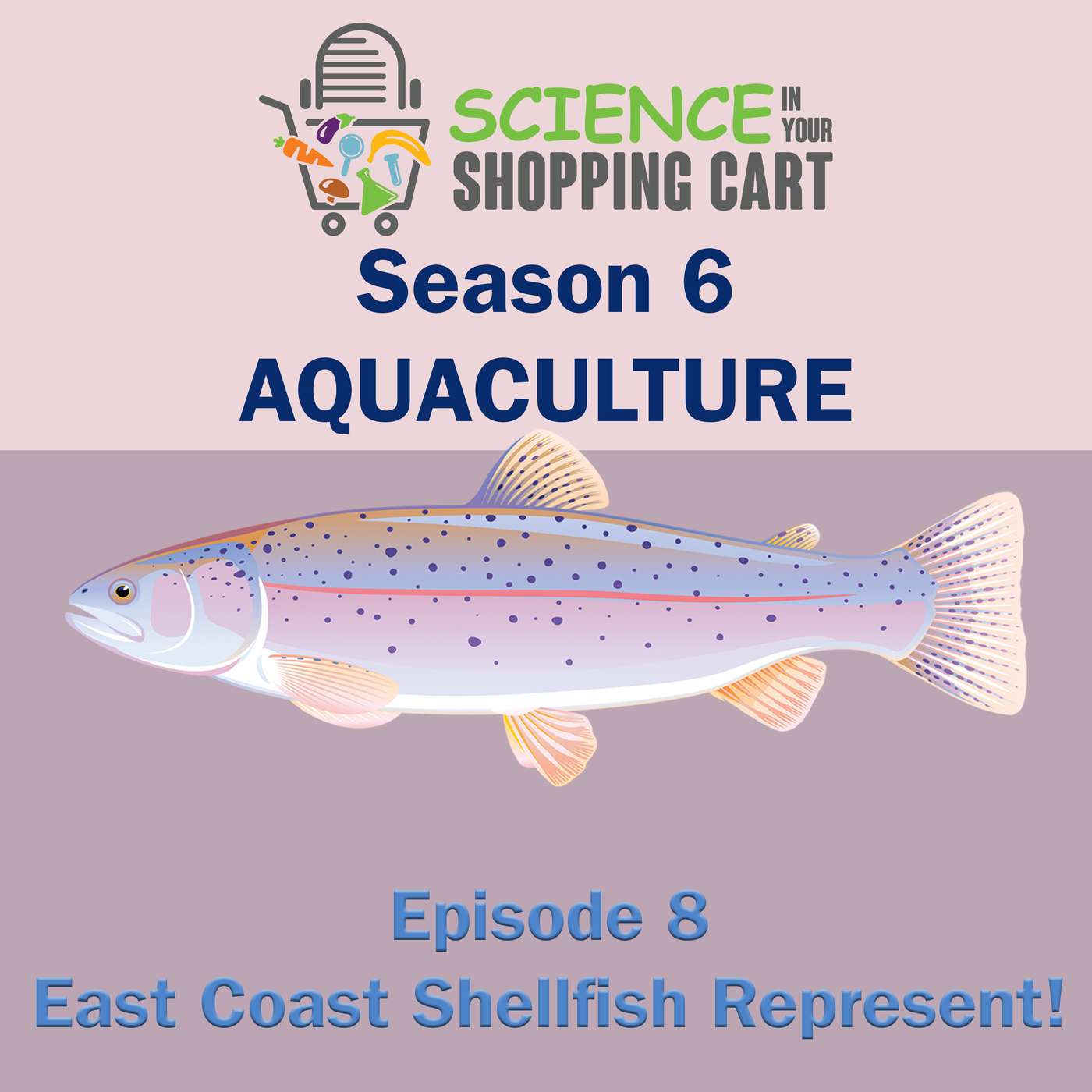 Science In Your Shopping CartSeason 6: Aquaculture | Episode 8: East Coast Shellfish Represent!An east coast perspective on how important shellfish are to our agriculture ecosystem and how their sustainability and low environmental impact makes the shellfish market the wave of the future.Connect with us: Twitter: @USDA_ARSFacebook: @AgriculturalResearchServiceLinkedIn: @usda-ars2024-07-0205 min
Science In Your Shopping CartSeason 6: Aquaculture | Episode 8: East Coast Shellfish Represent!An east coast perspective on how important shellfish are to our agriculture ecosystem and how their sustainability and low environmental impact makes the shellfish market the wave of the future.Connect with us: Twitter: @USDA_ARSFacebook: @AgriculturalResearchServiceLinkedIn: @usda-ars2024-07-0205 min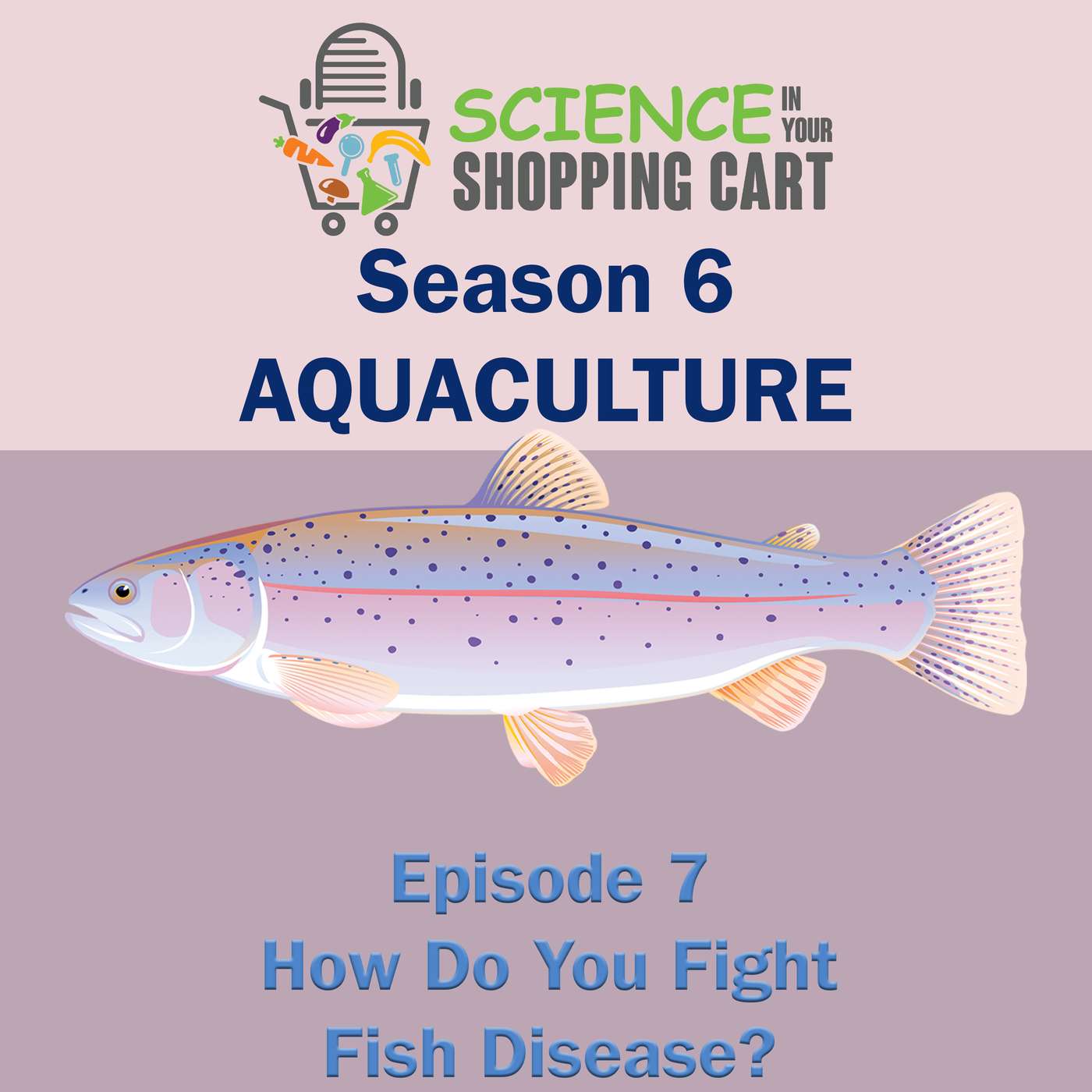 Science In Your Shopping CartSeason 6: Aquaculture | Episode 7: How Do You Fight Fish Disease?A healthy fish is a happy fish! ARS researchers are fighting fish diseases by developing vaccines, breeding fish strains that are resistant to select diseases, and providing guidance to the industry of best practices for keeping their fish healthy.Connect with us: Twitter: @USDA_ARSFacebook: @AgriculturalResearchServiceLinkedIn: @usda-ars2024-06-2505 min
Science In Your Shopping CartSeason 6: Aquaculture | Episode 7: How Do You Fight Fish Disease?A healthy fish is a happy fish! ARS researchers are fighting fish diseases by developing vaccines, breeding fish strains that are resistant to select diseases, and providing guidance to the industry of best practices for keeping their fish healthy.Connect with us: Twitter: @USDA_ARSFacebook: @AgriculturalResearchServiceLinkedIn: @usda-ars2024-06-2505 min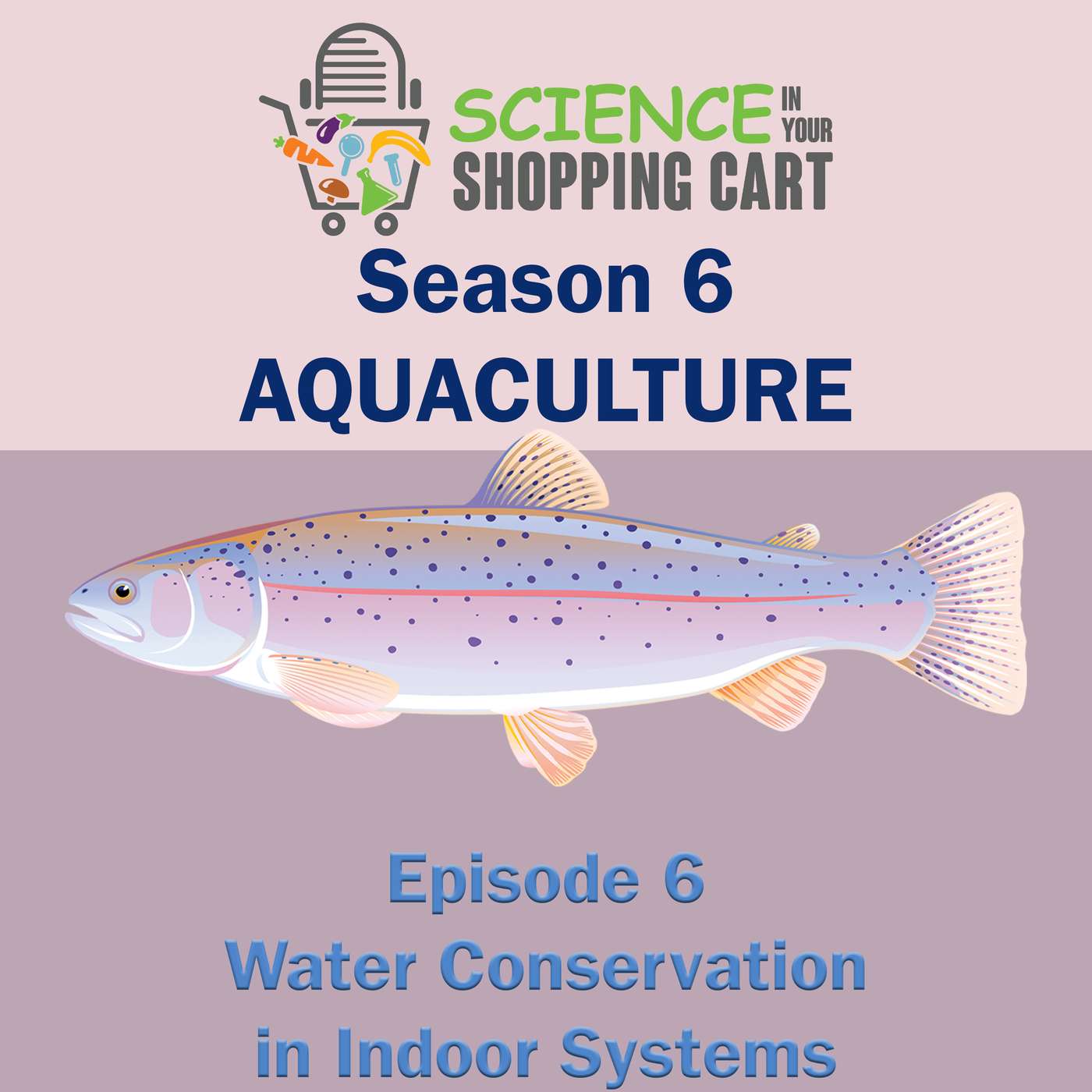 Science In Your Shopping CartSeason 6: Aquaculture | Episode 6: Water Conservation in Indoor SystemsTake a tour of an indoor recirculating system in Shepherdstown, West Virginia and learn how ARS researchers are using less fresh water while keeping optimal performance for fish rearing.Connect with us: Twitter: @USDA_ARSFacebook: @AgriculturalResearchServiceLinkedIn: @usda-ars2024-06-1808 min
Science In Your Shopping CartSeason 6: Aquaculture | Episode 6: Water Conservation in Indoor SystemsTake a tour of an indoor recirculating system in Shepherdstown, West Virginia and learn how ARS researchers are using less fresh water while keeping optimal performance for fish rearing.Connect with us: Twitter: @USDA_ARSFacebook: @AgriculturalResearchServiceLinkedIn: @usda-ars2024-06-1808 min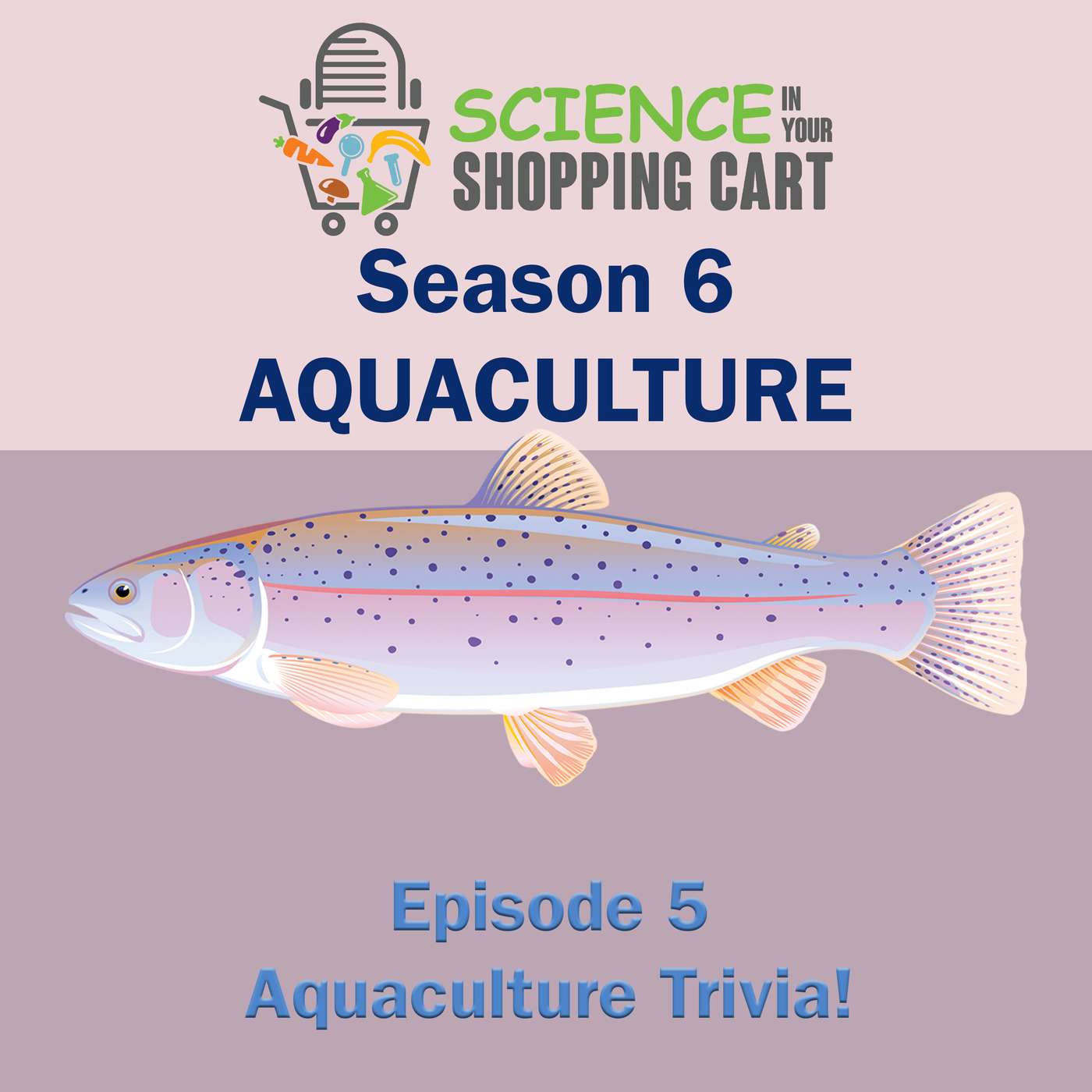 Science In Your Shopping CartSeason 6: Aquaculture | Episode 5: Aquaculture Trivia!Test your knowledge of aquaculture and learn some interesting facts.Connect with us: Twitter: @USDA_ARSFacebook: @AgriculturalResearchServiceLinkedIn: @usda-ars2024-06-1102 min
Science In Your Shopping CartSeason 6: Aquaculture | Episode 5: Aquaculture Trivia!Test your knowledge of aquaculture and learn some interesting facts.Connect with us: Twitter: @USDA_ARSFacebook: @AgriculturalResearchServiceLinkedIn: @usda-ars2024-06-1102 min Come Rain or ShineAdvancing Climate Services Across The Federal FamilyDr. Julian Reyes joins us to talk about climate services at the White House Office of Science and Technology Policy. Julian shares how his work involves uplifting climate services across the entire federal family and finding synergies across federal agencies to maximize benefits to society. Note: at the time of this recording, Dr. Julian Reyes held the position of Assistant Director for Climate Services at the White House Office of Science and Technology Policy; he has since moved on to a new position with a different employer.Relevant Links:Climate Mapping for...2024-06-0624 min
Come Rain or ShineAdvancing Climate Services Across The Federal FamilyDr. Julian Reyes joins us to talk about climate services at the White House Office of Science and Technology Policy. Julian shares how his work involves uplifting climate services across the entire federal family and finding synergies across federal agencies to maximize benefits to society. Note: at the time of this recording, Dr. Julian Reyes held the position of Assistant Director for Climate Services at the White House Office of Science and Technology Policy; he has since moved on to a new position with a different employer.Relevant Links:Climate Mapping for...2024-06-0624 min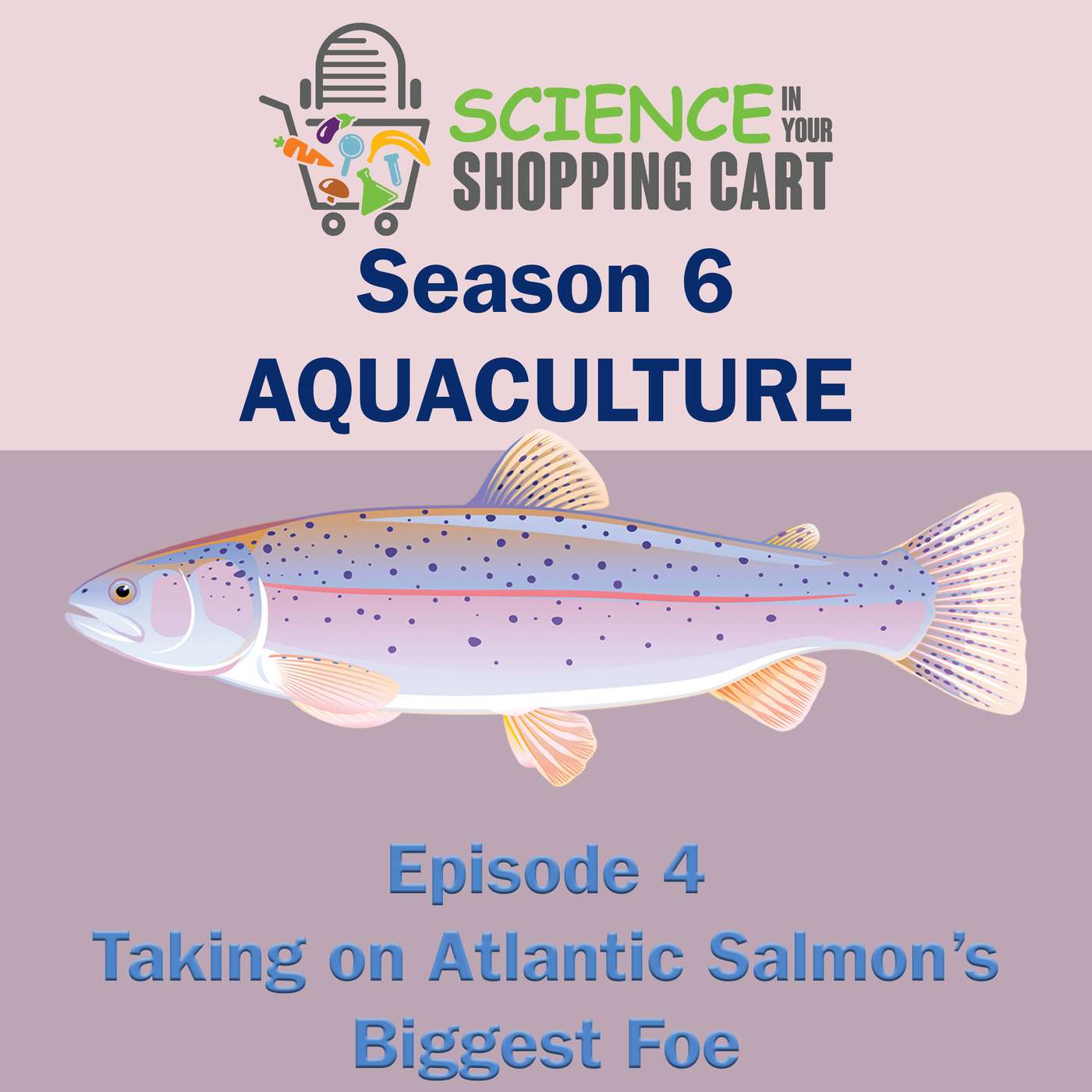 Science In Your Shopping CartSeason 6: Aquaculture | Episode 4: Taking on Atlantic Salmon's Biggest FoeSea lice is a huge problem in the seafood business. Not only does sea lice cause physical harm, but it can also stress the fish out, which can then affect their growth rate and ability to fight off other diseases. I mean, how would you like a blood sucker attached to your skin all the time? There currently are no vaccines or effective treatments for sea lice. However, ARS researchers are working to develop an Atlantic salmon strain that is resistant to sea lice.Connect with us: Twitter: @USDA_ARSFacebook: @AgriculturalResearchServiceLinkedIn: @usda-ars2024-06-0405 min
Science In Your Shopping CartSeason 6: Aquaculture | Episode 4: Taking on Atlantic Salmon's Biggest FoeSea lice is a huge problem in the seafood business. Not only does sea lice cause physical harm, but it can also stress the fish out, which can then affect their growth rate and ability to fight off other diseases. I mean, how would you like a blood sucker attached to your skin all the time? There currently are no vaccines or effective treatments for sea lice. However, ARS researchers are working to develop an Atlantic salmon strain that is resistant to sea lice.Connect with us: Twitter: @USDA_ARSFacebook: @AgriculturalResearchServiceLinkedIn: @usda-ars2024-06-0405 min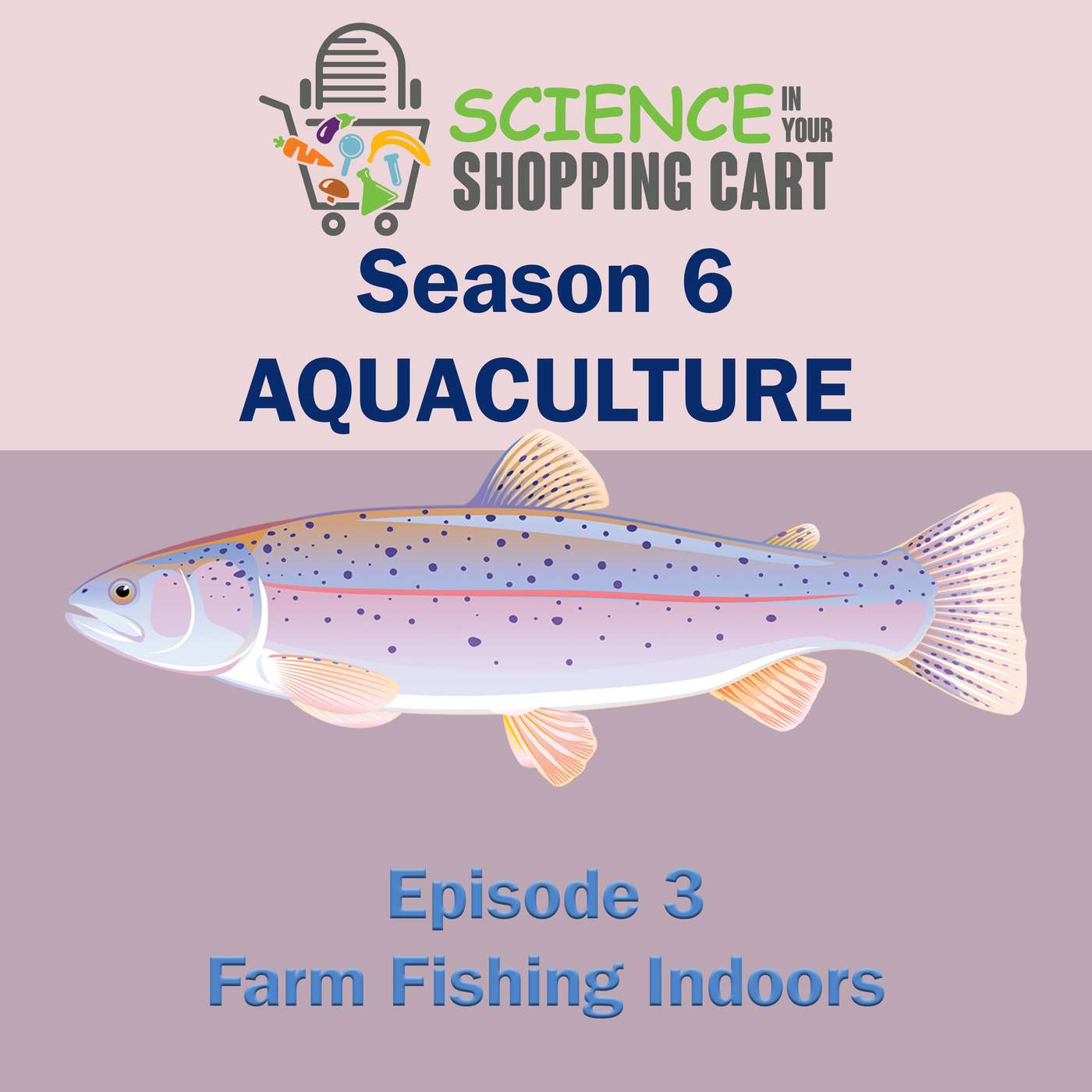 Science In Your Shopping CartSeason 6: Aquaculture | Episode 3: Farm Fishing IndoorsWhen you grow anything indoors, you can control a lot of the conditions, including temperature, irrigation, insect and disease resistance, and water quality and consumption. ARS researchers are using indoor recirculating systems to improve the health and yields of rainbow trout while maintaining great taste and market size.Connect with us: Twitter: @USDA_ARSFacebook: @AgriculturalResearchServiceLinkedIn: @usda-ars2024-05-2805 min
Science In Your Shopping CartSeason 6: Aquaculture | Episode 3: Farm Fishing IndoorsWhen you grow anything indoors, you can control a lot of the conditions, including temperature, irrigation, insect and disease resistance, and water quality and consumption. ARS researchers are using indoor recirculating systems to improve the health and yields of rainbow trout while maintaining great taste and market size.Connect with us: Twitter: @USDA_ARSFacebook: @AgriculturalResearchServiceLinkedIn: @usda-ars2024-05-2805 min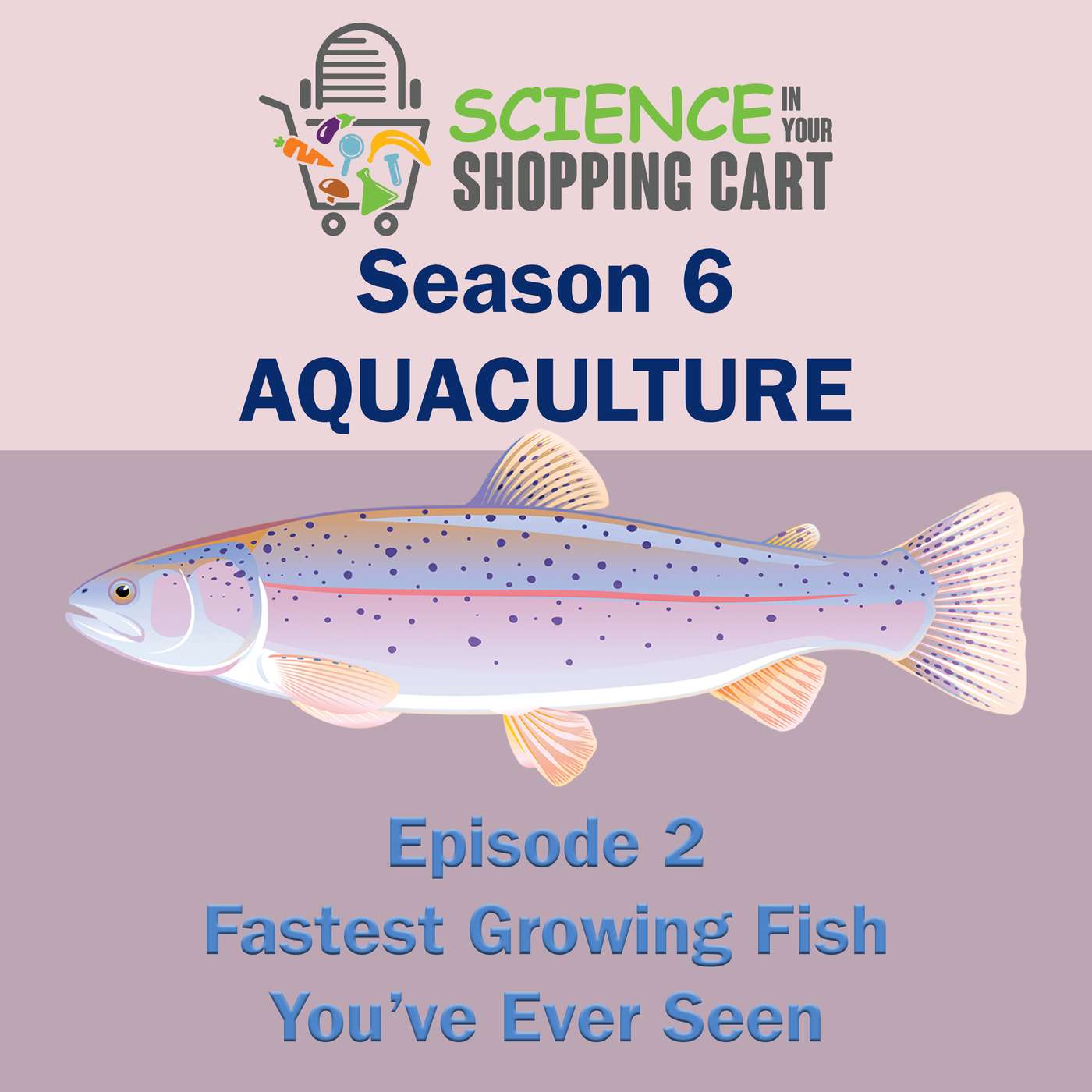 Science In Your Shopping CartSeason 6: Aquaculture | Episode 2: Fastest Growing Fish You've Ever SeenFish farmers are using natural contained aquifers to grow fish to market size at an incredible fast rate. That’s because aquifers can provide optimal conditions for fish rearing. Unfortunately, you can’t scale-up aquifers. ARS researchers are working with fish farmers to develop and implement best management practices to increase fish yields, health, and size of fish reared in aquifers.Connect with us: Twitter: @USDA_ARSFacebook: @AgriculturalResearchServiceLinkedIn: @usda-ars2024-05-2105 min
Science In Your Shopping CartSeason 6: Aquaculture | Episode 2: Fastest Growing Fish You've Ever SeenFish farmers are using natural contained aquifers to grow fish to market size at an incredible fast rate. That’s because aquifers can provide optimal conditions for fish rearing. Unfortunately, you can’t scale-up aquifers. ARS researchers are working with fish farmers to develop and implement best management practices to increase fish yields, health, and size of fish reared in aquifers.Connect with us: Twitter: @USDA_ARSFacebook: @AgriculturalResearchServiceLinkedIn: @usda-ars2024-05-2105 min Science In Your Shopping CartSeason 6: Aquaculture | Episode 1: Bringing Seafood Closer to HomeAquaculture, commonly known as fish farming, is a global multi-billion dollar industry, and is one of the fastest growing forms of food production. Unfortunately, most fish farming occurs overseas. ARS is helping the U.S. aquaculture industry provide more locally sourced seafood, including oysters, trout, salmon, catfish, and new varieties. In fact, you may soon be able to purchase seafood that was farm raised in your own city or town.Connect with us: Twitter: @USDA_ARSFacebook: @AgriculturalResearchServiceLinkedIn: @usda-ars2024-05-1406 min
Science In Your Shopping CartSeason 6: Aquaculture | Episode 1: Bringing Seafood Closer to HomeAquaculture, commonly known as fish farming, is a global multi-billion dollar industry, and is one of the fastest growing forms of food production. Unfortunately, most fish farming occurs overseas. ARS is helping the U.S. aquaculture industry provide more locally sourced seafood, including oysters, trout, salmon, catfish, and new varieties. In fact, you may soon be able to purchase seafood that was farm raised in your own city or town.Connect with us: Twitter: @USDA_ARSFacebook: @AgriculturalResearchServiceLinkedIn: @usda-ars2024-05-1406 min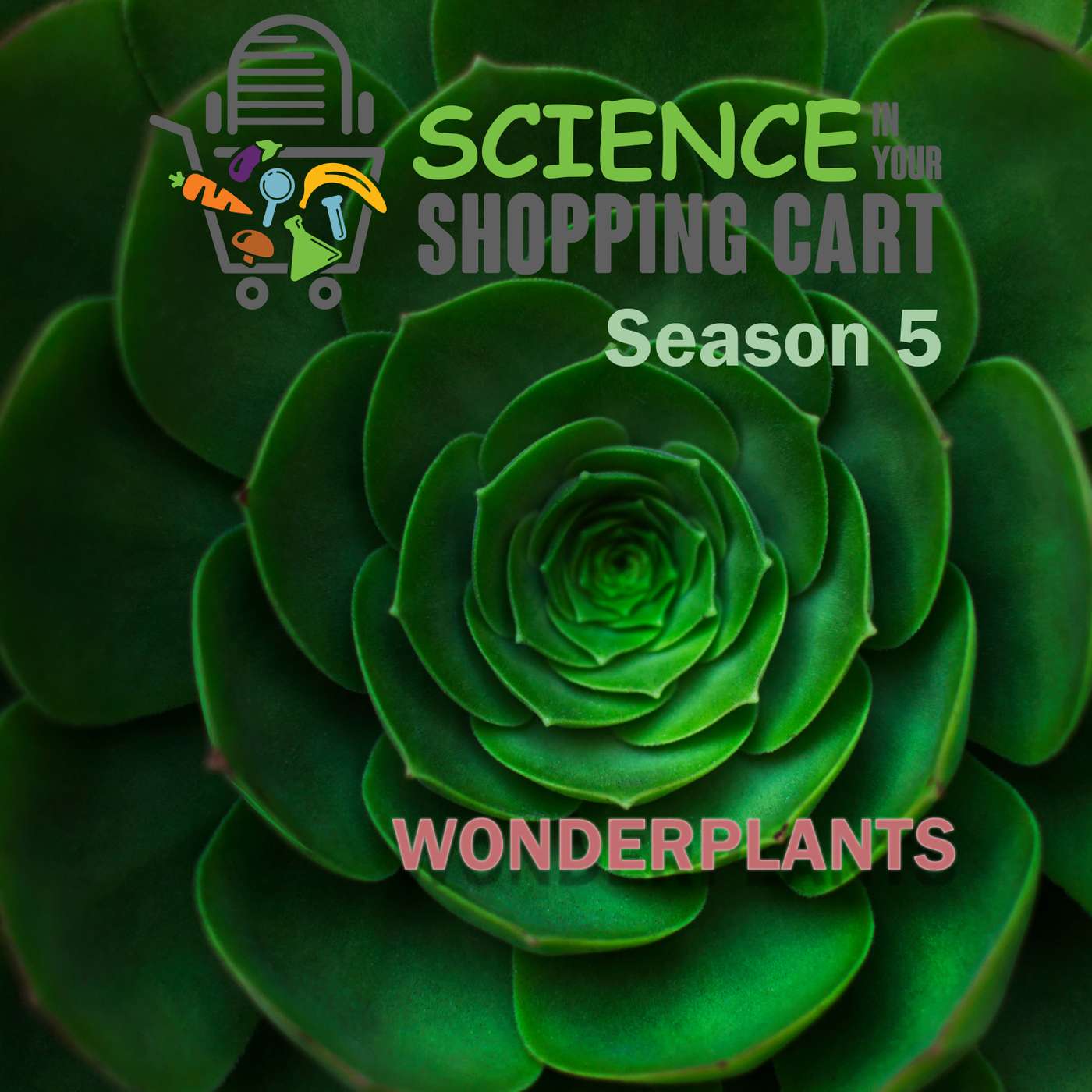 Science In Your Shopping CartSeason 5: WonderPlantsIn this episode of Science In Your Shopping Cart we take a tour of some super human plants that we use in our everyday lives to help feed and protect us.Connect with us: Twitter: @USDA_ARSFacebook: @AgriculturalResearchServiceLinkedIn: @usda-ars2024-05-0843 min
Science In Your Shopping CartSeason 5: WonderPlantsIn this episode of Science In Your Shopping Cart we take a tour of some super human plants that we use in our everyday lives to help feed and protect us.Connect with us: Twitter: @USDA_ARSFacebook: @AgriculturalResearchServiceLinkedIn: @usda-ars2024-05-0843 min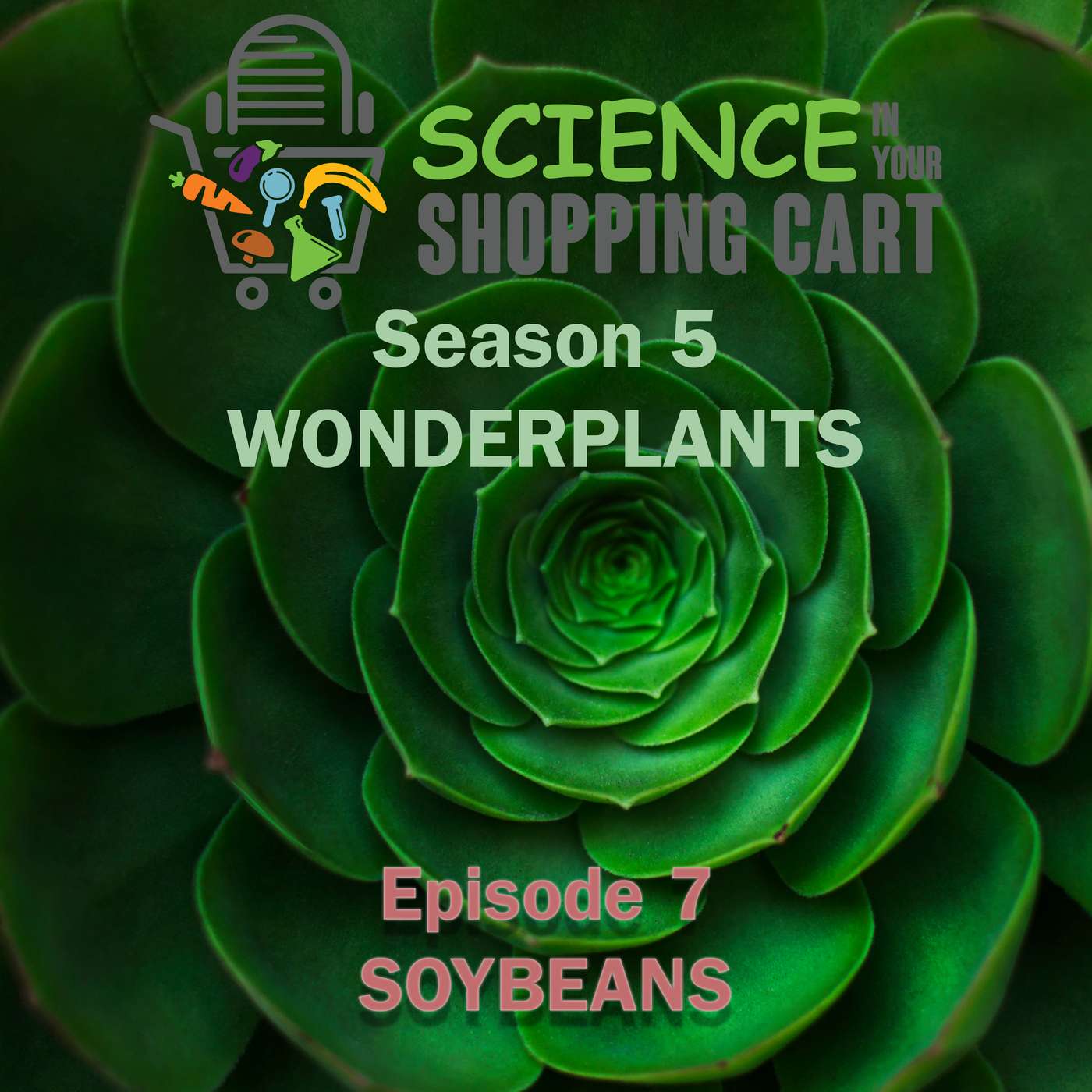 Science In Your Shopping CartSeason 5: WonderPlants | Episode 7: SoybeansLearn about this amazing wonderplant and some of the ways we use this plant in our everyday lives.Connect with us: Twitter: @USDA_ARSFacebook: @AgriculturalResearchServiceLinkedIn: @usda-ars2024-05-0703 min
Science In Your Shopping CartSeason 5: WonderPlants | Episode 7: SoybeansLearn about this amazing wonderplant and some of the ways we use this plant in our everyday lives.Connect with us: Twitter: @USDA_ARSFacebook: @AgriculturalResearchServiceLinkedIn: @usda-ars2024-05-0703 min Come Rain or ShineAgrivoltaics: Producing Food and Energy in the Same PlaceAgrivoltaics is the combination of agriculture and photovoltaics to create co-benefits across food, energy, and water systems. There is a lot of research being conducted around the benefits and best practices for implementation of agrivoltaics. We spoke with two experts, Dr. Greg Barron-Gafford from the University of Arizona, and Dr. Brandon Bestelmeyer, research leader at the Jornada Experimental Range, to learn more about this fairly new technology.Relevant links: Agrisolar ClearinghouseUniversity of Arizona Biosphere 2 - AgrivoltaicsJornada Experimental Range2024-05-0137 min
Come Rain or ShineAgrivoltaics: Producing Food and Energy in the Same PlaceAgrivoltaics is the combination of agriculture and photovoltaics to create co-benefits across food, energy, and water systems. There is a lot of research being conducted around the benefits and best practices for implementation of agrivoltaics. We spoke with two experts, Dr. Greg Barron-Gafford from the University of Arizona, and Dr. Brandon Bestelmeyer, research leader at the Jornada Experimental Range, to learn more about this fairly new technology.Relevant links: Agrisolar ClearinghouseUniversity of Arizona Biosphere 2 - AgrivoltaicsJornada Experimental Range2024-05-0137 min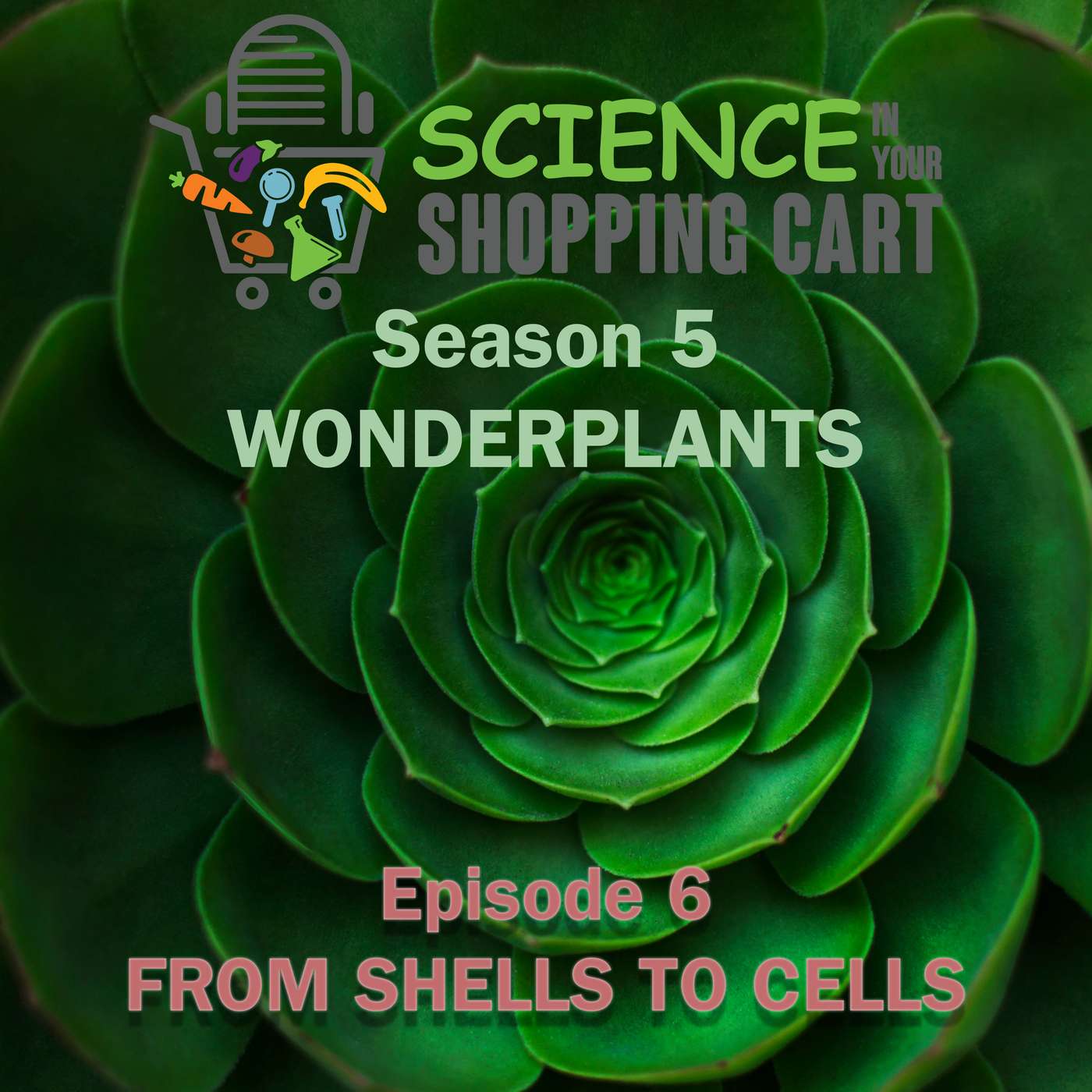 Science In Your Shopping CartSeason 5: WonderPlants | Episode 6: From Shells to CellsARS scientists are coming up with new ways to produce clean energy by developing a large filter-type application out of discarded almond shells that could capture and then store hydrogen, as well as other components for energy purposes. Connect with us: Twitter: @USDA_ARSFacebook: @AgriculturalResearchServiceLinkedIn: @usda-ars2024-04-3003 min
Science In Your Shopping CartSeason 5: WonderPlants | Episode 6: From Shells to CellsARS scientists are coming up with new ways to produce clean energy by developing a large filter-type application out of discarded almond shells that could capture and then store hydrogen, as well as other components for energy purposes. Connect with us: Twitter: @USDA_ARSFacebook: @AgriculturalResearchServiceLinkedIn: @usda-ars2024-04-3003 min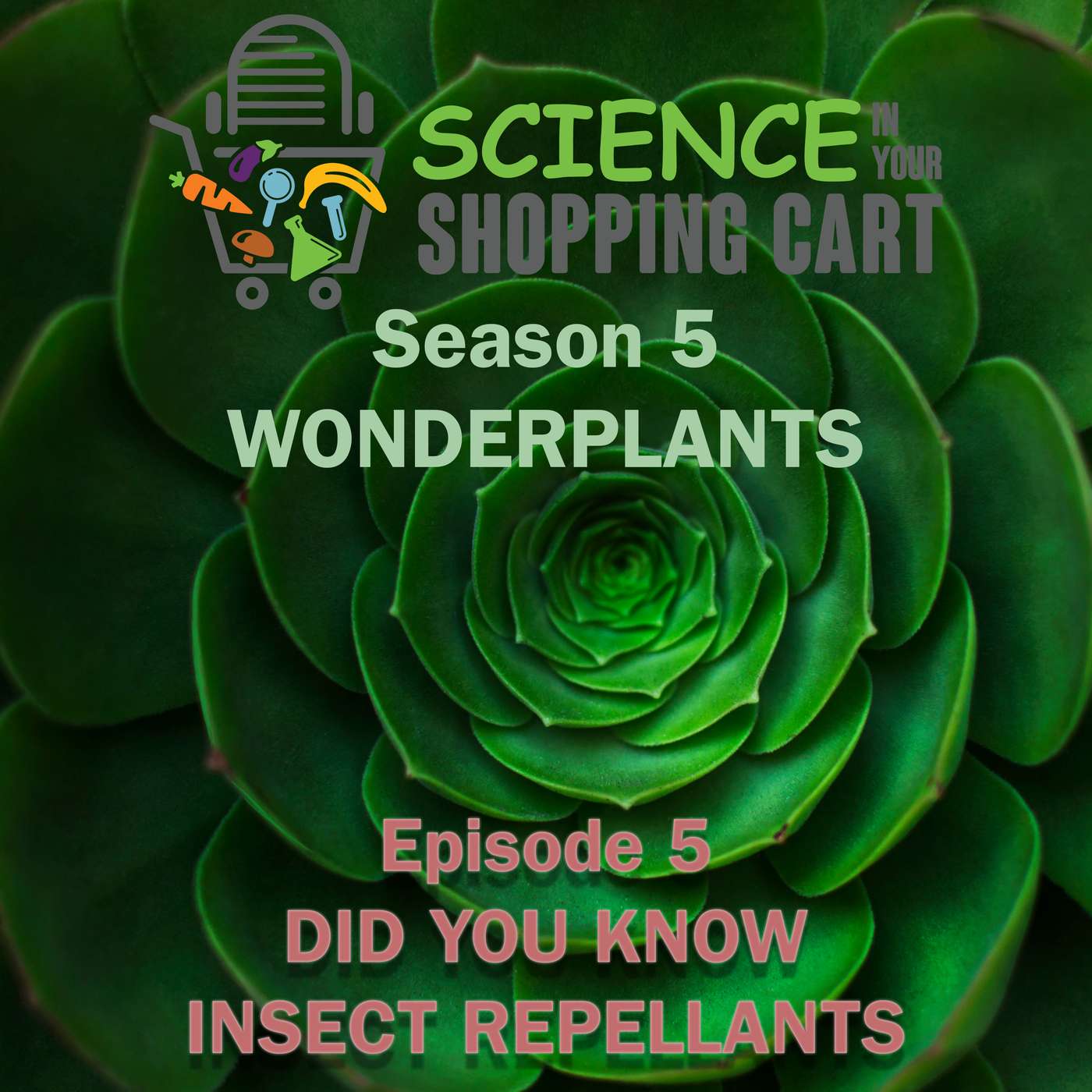 Science In Your Shopping CartSeason 5: WonderPlants | Episode 5: Did You Know - Insect RepellantsDid you know that some wonderplants can be used to control and even kill annoying flies and mosquitoes?Connect with us: Twitter: @USDA_ARSFacebook: @AgriculturalResearchServiceLinkedIn: @usda-ars2024-04-2302 min
Science In Your Shopping CartSeason 5: WonderPlants | Episode 5: Did You Know - Insect RepellantsDid you know that some wonderplants can be used to control and even kill annoying flies and mosquitoes?Connect with us: Twitter: @USDA_ARSFacebook: @AgriculturalResearchServiceLinkedIn: @usda-ars2024-04-2302 min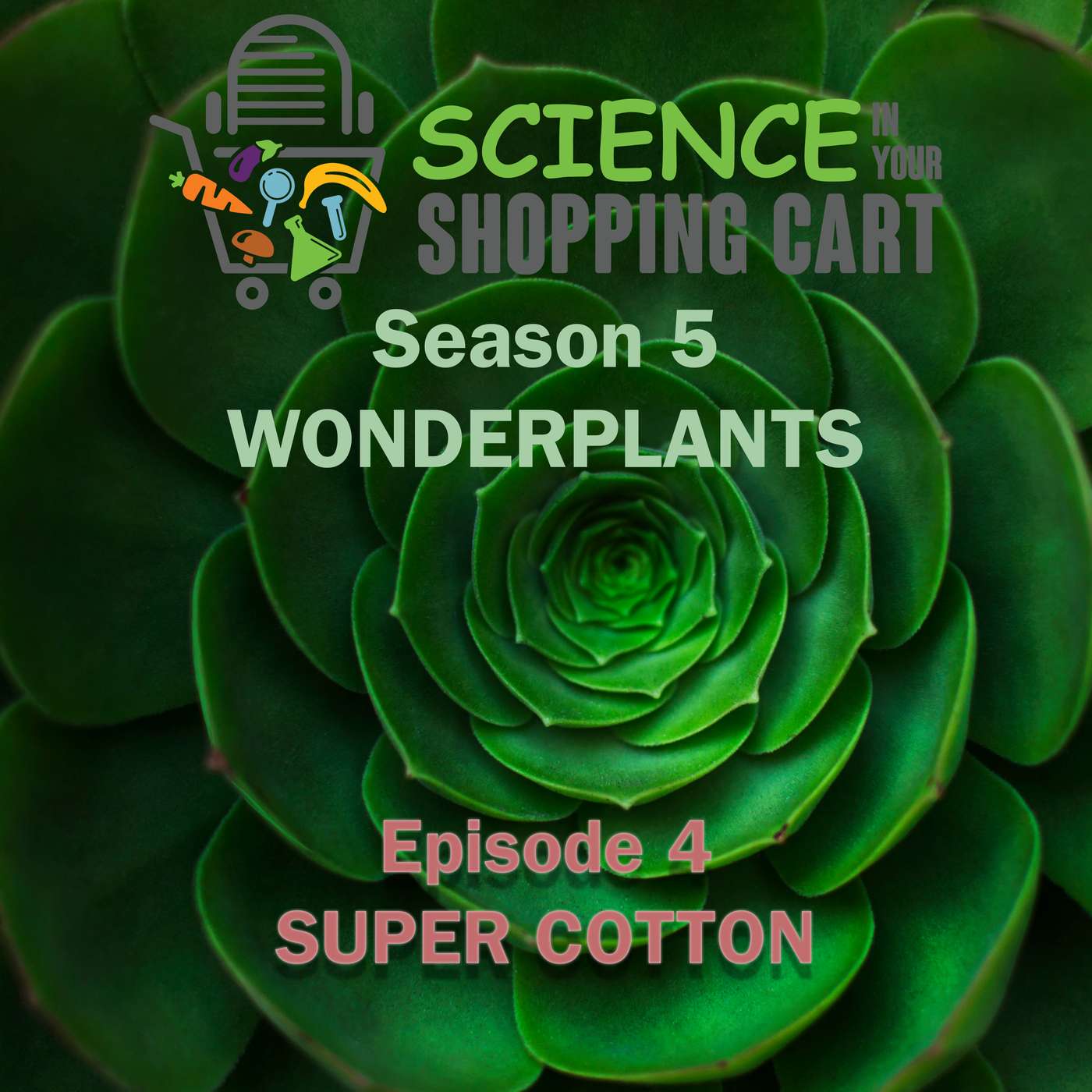 Science In Your Shopping CartSeason 5: WonderPlants | Episode 4: Super CottonARS scientists are turning nano fibers from cotton plants into mask filters, wound dressings, and other medical applications.Connect with us: Twitter: @USDA_ARSFacebook: @AgriculturalResearchServiceLinkedIn: @usda-ars2024-04-1605 min
Science In Your Shopping CartSeason 5: WonderPlants | Episode 4: Super CottonARS scientists are turning nano fibers from cotton plants into mask filters, wound dressings, and other medical applications.Connect with us: Twitter: @USDA_ARSFacebook: @AgriculturalResearchServiceLinkedIn: @usda-ars2024-04-1605 min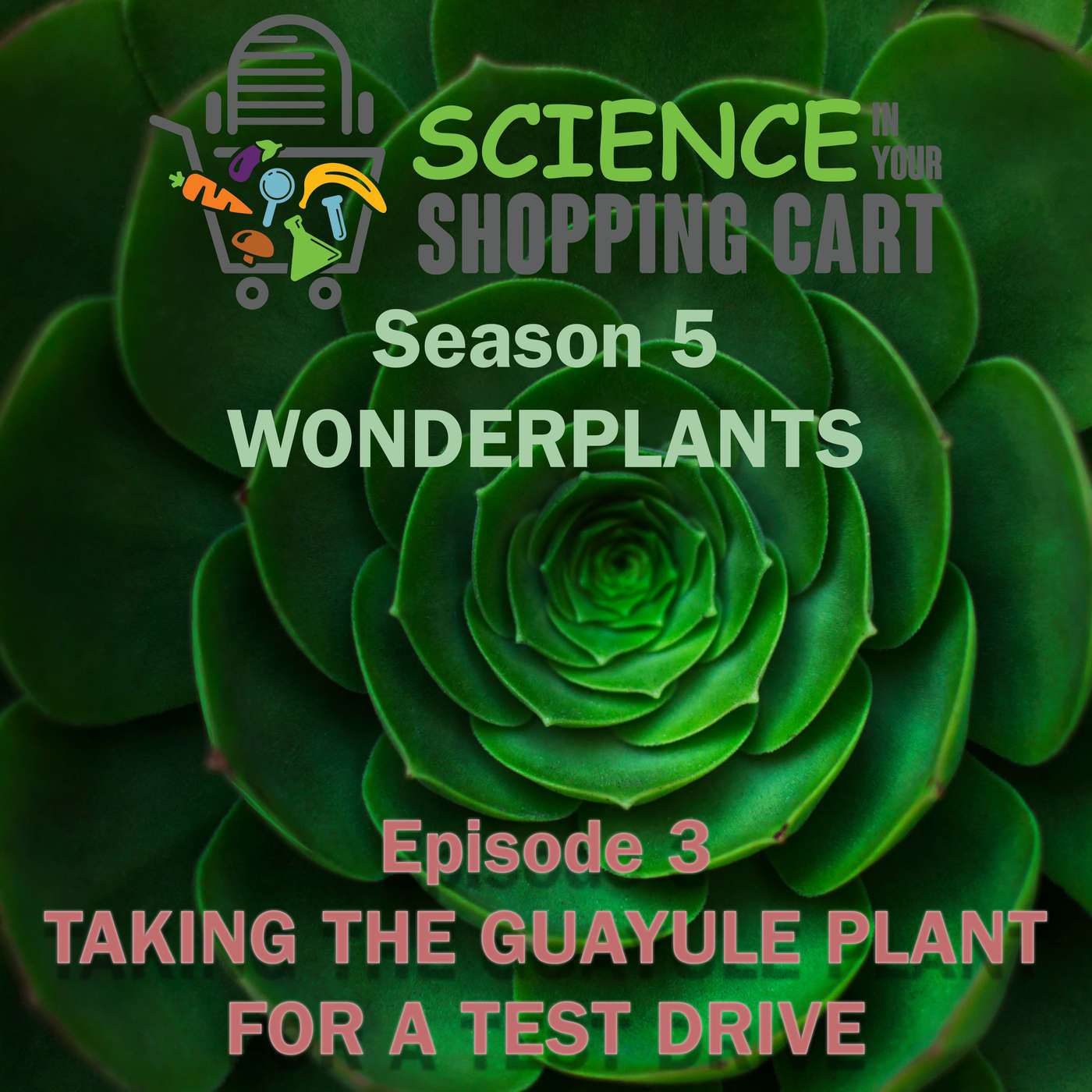 Science In Your Shopping CartSeason 5: WonderPlants | Episode 3: Taking the Guayule Plant for a Test DriveLearn about the amazing Guayule plant and how this desert loving plant is used in making tires, including a 100% Guayule tire!Connect with us: Twitter: @USDA_ARSFacebook: @AgriculturalResearchServiceLinkedIn: @usda-ars2024-04-0907 min
Science In Your Shopping CartSeason 5: WonderPlants | Episode 3: Taking the Guayule Plant for a Test DriveLearn about the amazing Guayule plant and how this desert loving plant is used in making tires, including a 100% Guayule tire!Connect with us: Twitter: @USDA_ARSFacebook: @AgriculturalResearchServiceLinkedIn: @usda-ars2024-04-0907 min Come Rain or ShineSolutions for Sustaining Environmental FlowsFlows in the Rio Chama, a tributary of the Rio Grande in northern New Mexico,have dwindled from drought and rising temperatures as well as diversion for agricultural irrigation. These diminished flows threaten groundwater resources and habitat for endangered plants and animals. Paul Tashjian, Director of Freshwater Conservation with Audubon Southwest, tells us about solutions that have been implemented to alleviate pressures on the Rio Chama and other waterways, bringing back flows for the natural habitat.Relevant Links:Five-Year Lease of Water Rights for Environmental Flows Along the Rio Chama2024-04-0326 min
Come Rain or ShineSolutions for Sustaining Environmental FlowsFlows in the Rio Chama, a tributary of the Rio Grande in northern New Mexico,have dwindled from drought and rising temperatures as well as diversion for agricultural irrigation. These diminished flows threaten groundwater resources and habitat for endangered plants and animals. Paul Tashjian, Director of Freshwater Conservation with Audubon Southwest, tells us about solutions that have been implemented to alleviate pressures on the Rio Chama and other waterways, bringing back flows for the natural habitat.Relevant Links:Five-Year Lease of Water Rights for Environmental Flows Along the Rio Chama2024-04-0326 min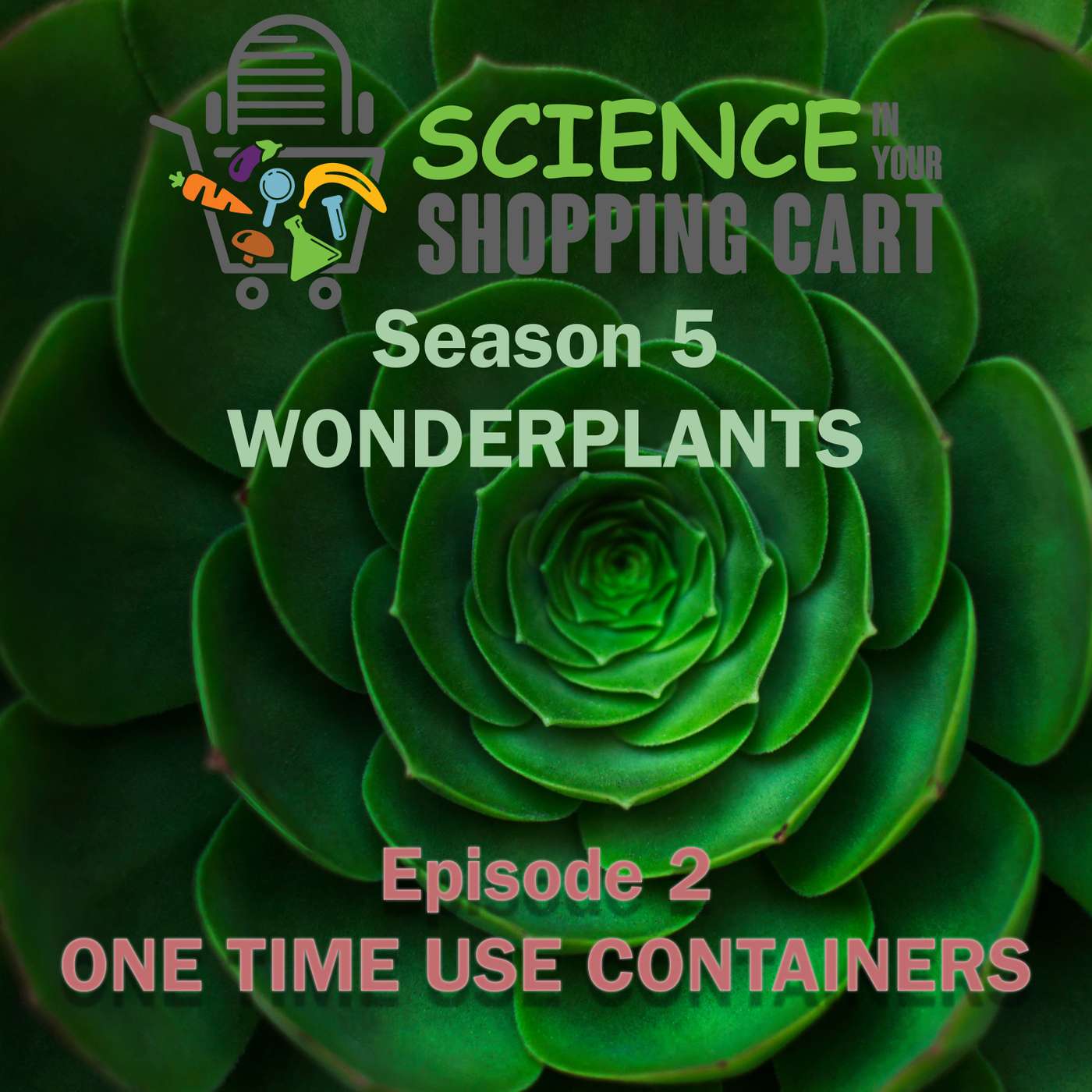 Science In Your Shopping CartSeason 5: WonderPlants | Episode 2: One Time Use ContainersARS scientists are turning plant fibers in to single-use containers to one day replace non-biodegradable plastic containers.Connect with us: Twitter: @USDA_ARSFacebook: @AgriculturalResearchServiceLinkedIn: @usda-ars2024-04-0208 min
Science In Your Shopping CartSeason 5: WonderPlants | Episode 2: One Time Use ContainersARS scientists are turning plant fibers in to single-use containers to one day replace non-biodegradable plastic containers.Connect with us: Twitter: @USDA_ARSFacebook: @AgriculturalResearchServiceLinkedIn: @usda-ars2024-04-0208 min Science In Your Shopping CartSeason 5: WonderPlants | Episode 1: National ArboretumCheck out some amazing wonderplants at the U.S. National Arboretum in Washington, DC.Connect with us: Twitter: @USDA_ARSFacebook: @AgriculturalResearchServiceLinkedIn: @usda-ars2024-03-2612 min
Science In Your Shopping CartSeason 5: WonderPlants | Episode 1: National ArboretumCheck out some amazing wonderplants at the U.S. National Arboretum in Washington, DC.Connect with us: Twitter: @USDA_ARSFacebook: @AgriculturalResearchServiceLinkedIn: @usda-ars2024-03-2612 min Science In Your Shopping CartSeason 4: BerriesIn this episode of Science In Your Shopping Cart we pull back the curtains to reveal how ARS scientists create new berry cultivars and work with the food industry to help farmers keep up with growing consumer demands for fresh fruit.Connect with us: Twitter: @USDA_ARSFacebook: @AgriculturalResearchServiceLinkedIn: @usda-ars2024-03-2023 min
Science In Your Shopping CartSeason 4: BerriesIn this episode of Science In Your Shopping Cart we pull back the curtains to reveal how ARS scientists create new berry cultivars and work with the food industry to help farmers keep up with growing consumer demands for fresh fruit.Connect with us: Twitter: @USDA_ARSFacebook: @AgriculturalResearchServiceLinkedIn: @usda-ars2024-03-2023 min Science In Your Shopping CartSeason 4: Berries | Episode 4: StrawberriesCheck out our newest strawberry, and hear how new strawberry cultivars are created.Connect with us: Twitter: @USDA_ARSFacebook: @AgriculturalResearchServiceLinkedIn: @usda-ars2024-03-1907 min
Science In Your Shopping CartSeason 4: Berries | Episode 4: StrawberriesCheck out our newest strawberry, and hear how new strawberry cultivars are created.Connect with us: Twitter: @USDA_ARSFacebook: @AgriculturalResearchServiceLinkedIn: @usda-ars2024-03-1907 min Science In Your Shopping CartSeason 4: Berries | Episode 3: BreaktimeTips on how to grow your own blueberry and blackberry plants right in your own backyard.Connect with us: Twitter: @USDA_ARSFacebook: @AgriculturalResearchServiceLinkedIn: @usda-ars2024-03-1201 min
Science In Your Shopping CartSeason 4: Berries | Episode 3: BreaktimeTips on how to grow your own blueberry and blackberry plants right in your own backyard.Connect with us: Twitter: @USDA_ARSFacebook: @AgriculturalResearchServiceLinkedIn: @usda-ars2024-03-1201 min Come Rain or ShineClimate Change, Coastlines, and AquacultureHow is climate change affecting our coasts and ocean? What about aquaculture? Halley Froehlich, an expert in climate change impacts to coasts and oceans, with a strong focus on aquaculture, joins us to discuss this important topic as we wrap up our series highlighting Key Messages in the Southwest Chapter of the 5th National Climate Assessment.Relevant links:Read the 5th National Climate Assessment (NCA5)Webinars and podcasts on the NCA5NCA5 Atlas2024-03-0636 min
Come Rain or ShineClimate Change, Coastlines, and AquacultureHow is climate change affecting our coasts and ocean? What about aquaculture? Halley Froehlich, an expert in climate change impacts to coasts and oceans, with a strong focus on aquaculture, joins us to discuss this important topic as we wrap up our series highlighting Key Messages in the Southwest Chapter of the 5th National Climate Assessment.Relevant links:Read the 5th National Climate Assessment (NCA5)Webinars and podcasts on the NCA5NCA5 Atlas2024-03-0636 min Science In Your Shopping CartSeason 4: Berries | Episode 2: Blackberries and RaspberriesARS scientists created a thornless blackberry plant along with many new varieties of blackberries for the agricultural industry and a trellis system designed to protect and help pickers harvest blackberries. ARS scientists are also working with the individually quick frozen industry to pack the great taste of raspberries into your cool treats.Connect with us: Twitter: @USDA_ARSFacebook: @AgriculturalResearchServiceLinkedIn: @usda-ars2024-03-0506 min
Science In Your Shopping CartSeason 4: Berries | Episode 2: Blackberries and RaspberriesARS scientists created a thornless blackberry plant along with many new varieties of blackberries for the agricultural industry and a trellis system designed to protect and help pickers harvest blackberries. ARS scientists are also working with the individually quick frozen industry to pack the great taste of raspberries into your cool treats.Connect with us: Twitter: @USDA_ARSFacebook: @AgriculturalResearchServiceLinkedIn: @usda-ars2024-03-0506 min Science In Your Shopping CartSeason 3: BiomassLearn about innovations and research that ARS scientists are conducting to turn farm waste, called Biomass, into environmentally friendly products.Connect with us: Twitter: @USDA_ARSFacebook: @AgriculturalResearchServiceLinkedIn: @usda-ars2024-02-2119 min
Science In Your Shopping CartSeason 3: BiomassLearn about innovations and research that ARS scientists are conducting to turn farm waste, called Biomass, into environmentally friendly products.Connect with us: Twitter: @USDA_ARSFacebook: @AgriculturalResearchServiceLinkedIn: @usda-ars2024-02-2119 min Science In Your Shopping CartSeason 3: Biomass | Episode 4: Bioproducts from Corn WasteLearn about innovations and research that ARS scientists are conducting to produce biopolymers such as nanocellulose from corn waste as a replacement for popular synthetic plastic products.Connect with us: Twitter: @USDA_ARSFacebook: @AgriculturalResearchServiceLinkedIn: @usda-ars2024-02-2006 min
Science In Your Shopping CartSeason 3: Biomass | Episode 4: Bioproducts from Corn WasteLearn about innovations and research that ARS scientists are conducting to produce biopolymers such as nanocellulose from corn waste as a replacement for popular synthetic plastic products.Connect with us: Twitter: @USDA_ARSFacebook: @AgriculturalResearchServiceLinkedIn: @usda-ars2024-02-2006 min Science In Your Shopping CartSeason 3: Biomass | Episode 3: BreaktimeTake a look at some cool ARS developments that are benefiting our ecosystem.Connect with us: Twitter: @USDA_ARSFacebook: @AgriculturalResearchServiceLinkedIn: @usda-ars2024-02-1301 min
Science In Your Shopping CartSeason 3: Biomass | Episode 3: BreaktimeTake a look at some cool ARS developments that are benefiting our ecosystem.Connect with us: Twitter: @USDA_ARSFacebook: @AgriculturalResearchServiceLinkedIn: @usda-ars2024-02-1301 min Come Rain or ShineFifth National Climate Assessment, Southwest Chapter: Health, Water, Agriculture, and WildfireWe continue our discussion of the Southwest Chapter of the 5th National Climate Assessment (NCA5). Each Chapter of NCA5 is organized around Key Messages. This month we interviewed the lead authors of four Key Messages in the Southwest Chapter, covering human health, water, agriculture, and wildfire. Each author shares what they would like people to know and what they found hopeful or encouraging within their Key Message topic.Relevant links:Read the 5th National Climate Assessment (NCA5)Webinars and podcasts on the NCA5NCA5...2024-02-0733 min
Come Rain or ShineFifth National Climate Assessment, Southwest Chapter: Health, Water, Agriculture, and WildfireWe continue our discussion of the Southwest Chapter of the 5th National Climate Assessment (NCA5). Each Chapter of NCA5 is organized around Key Messages. This month we interviewed the lead authors of four Key Messages in the Southwest Chapter, covering human health, water, agriculture, and wildfire. Each author shares what they would like people to know and what they found hopeful or encouraging within their Key Message topic.Relevant links:Read the 5th National Climate Assessment (NCA5)Webinars and podcasts on the NCA5NCA5...2024-02-0733 min Science In Your Shopping CartSeason 3: Biomass | Episode 2: Polymers from Cotton Gin TrashLearn about innovations and research that ARS scientists are conducting to turn cotton waste into agro-based biodegradable polymers.Connect with us: Twitter: @USDA_ARSFacebook: @AgriculturalResearchServiceLinkedIn: @usda-ars2024-02-0604 min
Science In Your Shopping CartSeason 3: Biomass | Episode 2: Polymers from Cotton Gin TrashLearn about innovations and research that ARS scientists are conducting to turn cotton waste into agro-based biodegradable polymers.Connect with us: Twitter: @USDA_ARSFacebook: @AgriculturalResearchServiceLinkedIn: @usda-ars2024-02-0604 min Science In Your Shopping CartSeason 3: Biomass | Episode 1: Pallets from Almond ShellsARS scientists are turning agricultural waste (Biomass) into environmentally friendly products that can replace non-biodegradable plastics.Connect with us: Twitter: @USDA_ARSFacebook: @AgriculturalResearchServiceLinkedIn: @usda-ars2024-01-3006 min
Science In Your Shopping CartSeason 3: Biomass | Episode 1: Pallets from Almond ShellsARS scientists are turning agricultural waste (Biomass) into environmentally friendly products that can replace non-biodegradable plastics.Connect with us: Twitter: @USDA_ARSFacebook: @AgriculturalResearchServiceLinkedIn: @usda-ars2024-01-3006 min Science In Your Shopping CartSeason 2: Apples: Get Crunchin'Apples are as American as apple pie. Let's look at some cool innovations and research that ARS scientists are conducting to ensure those apples in your shopping cart are fresh, tasty, cost-friendly, and high quality.Connect with us: Twitter: @USDA_ARSFacebook: @AgriculturalResearchServiceLinkedIn: @usda-ars2024-01-2429 min
Science In Your Shopping CartSeason 2: Apples: Get Crunchin'Apples are as American as apple pie. Let's look at some cool innovations and research that ARS scientists are conducting to ensure those apples in your shopping cart are fresh, tasty, cost-friendly, and high quality.Connect with us: Twitter: @USDA_ARSFacebook: @AgriculturalResearchServiceLinkedIn: @usda-ars2024-01-2429 min Science In Your Shopping CartSeason 2: Apples: Get Crunchin' | Episode 6: Rapid BreedingThe apple industry is a highly impactful business for the U.S. Growers are always looking for new varieties that are not only tasty but more resistant to disease outbreaks and environmental stressors that can severely reduce apple production. However, developing new varieties can take decades before they appear in your grocery market. ARS researchers have developed rapid breeding techniques to drastically speed up the process, bringing those new varieties of apples to your shopping cart much sooner than before.Connect with us: Twitter: @USDA_ARSFacebook: @AgriculturalResearchServiceLinkedIn: @usda-ars2024-01-2306 min
Science In Your Shopping CartSeason 2: Apples: Get Crunchin' | Episode 6: Rapid BreedingThe apple industry is a highly impactful business for the U.S. Growers are always looking for new varieties that are not only tasty but more resistant to disease outbreaks and environmental stressors that can severely reduce apple production. However, developing new varieties can take decades before they appear in your grocery market. ARS researchers have developed rapid breeding techniques to drastically speed up the process, bringing those new varieties of apples to your shopping cart much sooner than before.Connect with us: Twitter: @USDA_ARSFacebook: @AgriculturalResearchServiceLinkedIn: @usda-ars2024-01-2306 min Science In Your Shopping CartSeason 2: Apples: Get Crunchin' | Episode 5: Mysterious DiseaseApple growers have a mystery on their hands. Something is killing popular dwarf apple trees, but researchers are unsure if the cause is environmental, viral, soil-based, or something else. ARS scientists are on the case!Connect with us: Twitter: @USDA_ARSFacebook: @AgriculturalResearchServiceLinkedIn: @usda-ars2024-01-1604 min
Science In Your Shopping CartSeason 2: Apples: Get Crunchin' | Episode 5: Mysterious DiseaseApple growers have a mystery on their hands. Something is killing popular dwarf apple trees, but researchers are unsure if the cause is environmental, viral, soil-based, or something else. ARS scientists are on the case!Connect with us: Twitter: @USDA_ARSFacebook: @AgriculturalResearchServiceLinkedIn: @usda-ars2024-01-1604 min Science In Your Shopping CartSeason 2: Apples: Get Crunchin' | Episode 4: Snack BreakReady for a snack break? Then sink your teeth into this apple trivia. You'll finally be able to answer the question, "What does a 200-year old apple tree and a train have in common?"Connect with us: Twitter: @USDA_ARSFacebook: @AgriculturalResearchServiceLinkedIn: @usda-ars2024-01-0901 min
Science In Your Shopping CartSeason 2: Apples: Get Crunchin' | Episode 4: Snack BreakReady for a snack break? Then sink your teeth into this apple trivia. You'll finally be able to answer the question, "What does a 200-year old apple tree and a train have in common?"Connect with us: Twitter: @USDA_ARSFacebook: @AgriculturalResearchServiceLinkedIn: @usda-ars2024-01-0901 min Come Rain or ShineInside the Fifth National Climate Assessment, Southwest ChapterDrs. Emile Elias and Dave White discuss the Southwest chapter of the 5th National Climate Assessment (NCA5). They share what it was like to be lead authors of the Southwest chapter, what’s new in this assessment, how it’s being shared, some major findings, and other highlights. We wrap up this episode with what each of them found encouraging or hopeful from the assessment.Relevant links:Read the 5th National Climate Assessment (NCA5)Webinars and podcasts on the NCA5NC...2024-01-0351 min
Come Rain or ShineInside the Fifth National Climate Assessment, Southwest ChapterDrs. Emile Elias and Dave White discuss the Southwest chapter of the 5th National Climate Assessment (NCA5). They share what it was like to be lead authors of the Southwest chapter, what’s new in this assessment, how it’s being shared, some major findings, and other highlights. We wrap up this episode with what each of them found encouraging or hopeful from the assessment.Relevant links:Read the 5th National Climate Assessment (NCA5)Webinars and podcasts on the NCA5NC...2024-01-0351 min Science In Your Shopping CartSeason 2: Apples: Get Crunchin' | Episode 3: Precision SprayerThese days, we are all more conscious of pesticide spraying, especially growers who rely on this method for keeping pests off their crops. ARS scientists have developed a revolutionary laser-guided sprayer to apply precise amounts of pesticide to their crops, cutting down significantly on the amount of pesticide sprayed onto fruits and vegetables.Connect with us: Twitter: @USDA_ARSFacebook: @AgriculturalResearchServiceLinkedIn: @usda-ars2024-01-0204 min
Science In Your Shopping CartSeason 2: Apples: Get Crunchin' | Episode 3: Precision SprayerThese days, we are all more conscious of pesticide spraying, especially growers who rely on this method for keeping pests off their crops. ARS scientists have developed a revolutionary laser-guided sprayer to apply precise amounts of pesticide to their crops, cutting down significantly on the amount of pesticide sprayed onto fruits and vegetables.Connect with us: Twitter: @USDA_ARSFacebook: @AgriculturalResearchServiceLinkedIn: @usda-ars2024-01-0204 min Science In Your Shopping CartSeason 2: Apples: Get Crunchin' | Episode 2: Apple Sorting MachineARS researchers have developed an in-field apple sorting machine that not only improves apple picking efficiency, but also scans and grades apples. Think of it as a 21st century solution to apple picking and harvesting.Connect with us: Twitter: @USDA_ARSFacebook: @AgriculturalResearchServiceLinkedIn: @usda-ars2023-12-2604 min
Science In Your Shopping CartSeason 2: Apples: Get Crunchin' | Episode 2: Apple Sorting MachineARS researchers have developed an in-field apple sorting machine that not only improves apple picking efficiency, but also scans and grades apples. Think of it as a 21st century solution to apple picking and harvesting.Connect with us: Twitter: @USDA_ARSFacebook: @AgriculturalResearchServiceLinkedIn: @usda-ars2023-12-2604 min Science In Your Shopping CartSeason 2: Apples: Get Crunchin' | Episode 1: Apple RootstocksDid you know that the apple you're eating right now probably came from a rootstock developed by ARS? Our scientists are breeding new rootstocks that are more resistant to pests and diseases, that bear more delicious fruit, and are more ideal for apple growers to pick and prune.Connect with us: Twitter: @USDA_ARSFacebook: @AgriculturalResearchServiceLinkedIn: @usda-ars2023-12-1907 min
Science In Your Shopping CartSeason 2: Apples: Get Crunchin' | Episode 1: Apple RootstocksDid you know that the apple you're eating right now probably came from a rootstock developed by ARS? Our scientists are breeding new rootstocks that are more resistant to pests and diseases, that bear more delicious fruit, and are more ideal for apple growers to pick and prune.Connect with us: Twitter: @USDA_ARSFacebook: @AgriculturalResearchServiceLinkedIn: @usda-ars2023-12-1907 min Science In Your Shopping CartSeason 1: Spinach, Tomatoes, & Potatoes: What Do They All Have In Common?We know that all three are vegetables, or two vegetables and a fruit if you will, but what else do they have in common? Take a virtual trip with us to Italy, Idaho, and California to find out.Connect with us: Twitter: @USDA_ARSFacebook: @AgriculturalResearchServiceLinkedIn: @usda-ars2023-12-1314 min
Science In Your Shopping CartSeason 1: Spinach, Tomatoes, & Potatoes: What Do They All Have In Common?We know that all three are vegetables, or two vegetables and a fruit if you will, but what else do they have in common? Take a virtual trip with us to Italy, Idaho, and California to find out.Connect with us: Twitter: @USDA_ARSFacebook: @AgriculturalResearchServiceLinkedIn: @usda-ars2023-12-1314 min Science In Your Shopping CartSeason 1: Tomatoes, Potatoes & Spinach | Episode 3: SpinachMaking Popeye proud. ARS recently released the world’s first true red spinach, called “USDA Red”. Learn about the benefits this new powerful vegetable provides to consumers.Connect with us: Twitter: @USDA_ARSFacebook: @AgriculturalResearchServiceLinkedIn: @usda-ars2023-12-1204 min
Science In Your Shopping CartSeason 1: Tomatoes, Potatoes & Spinach | Episode 3: SpinachMaking Popeye proud. ARS recently released the world’s first true red spinach, called “USDA Red”. Learn about the benefits this new powerful vegetable provides to consumers.Connect with us: Twitter: @USDA_ARSFacebook: @AgriculturalResearchServiceLinkedIn: @usda-ars2023-12-1204 min Come Rain or ShineHarvesting Hope: Tackling Food Waste, Hunger, and Climate ChangeWe speak with the directors of two non-profit organizations who are turning problems into solutions by getting nutritious food that would normally go to waste back into our food system and into the hands of those who can use it - reducing waste, methane emissions, and fighting food insecurity all at the same time. Cover Image credit: USDA Photo by Lance CheungRelevant links: Association of Gleaning OrganizationsFalling FruitNational Gleaning ProjectBill E...2023-12-0646 min
Come Rain or ShineHarvesting Hope: Tackling Food Waste, Hunger, and Climate ChangeWe speak with the directors of two non-profit organizations who are turning problems into solutions by getting nutritious food that would normally go to waste back into our food system and into the hands of those who can use it - reducing waste, methane emissions, and fighting food insecurity all at the same time. Cover Image credit: USDA Photo by Lance CheungRelevant links: Association of Gleaning OrganizationsFalling FruitNational Gleaning ProjectBill E...2023-12-0646 min